Hewlett Packard Enterprise MSR4000DFS Outdoor 802.11a/b/g/n Access Point User Manual MSR4000 Series IG Rev 02
Aruba Networks, Inc. Outdoor 802.11a/b/g/n Access Point MSR4000 Series IG Rev 02
Contents
- 1. Installation Guide
- 2. ProfInstall-Instruction
- 3. Revised Installation Guide
- 4. updated Installation Guide
Revised Installation Guide
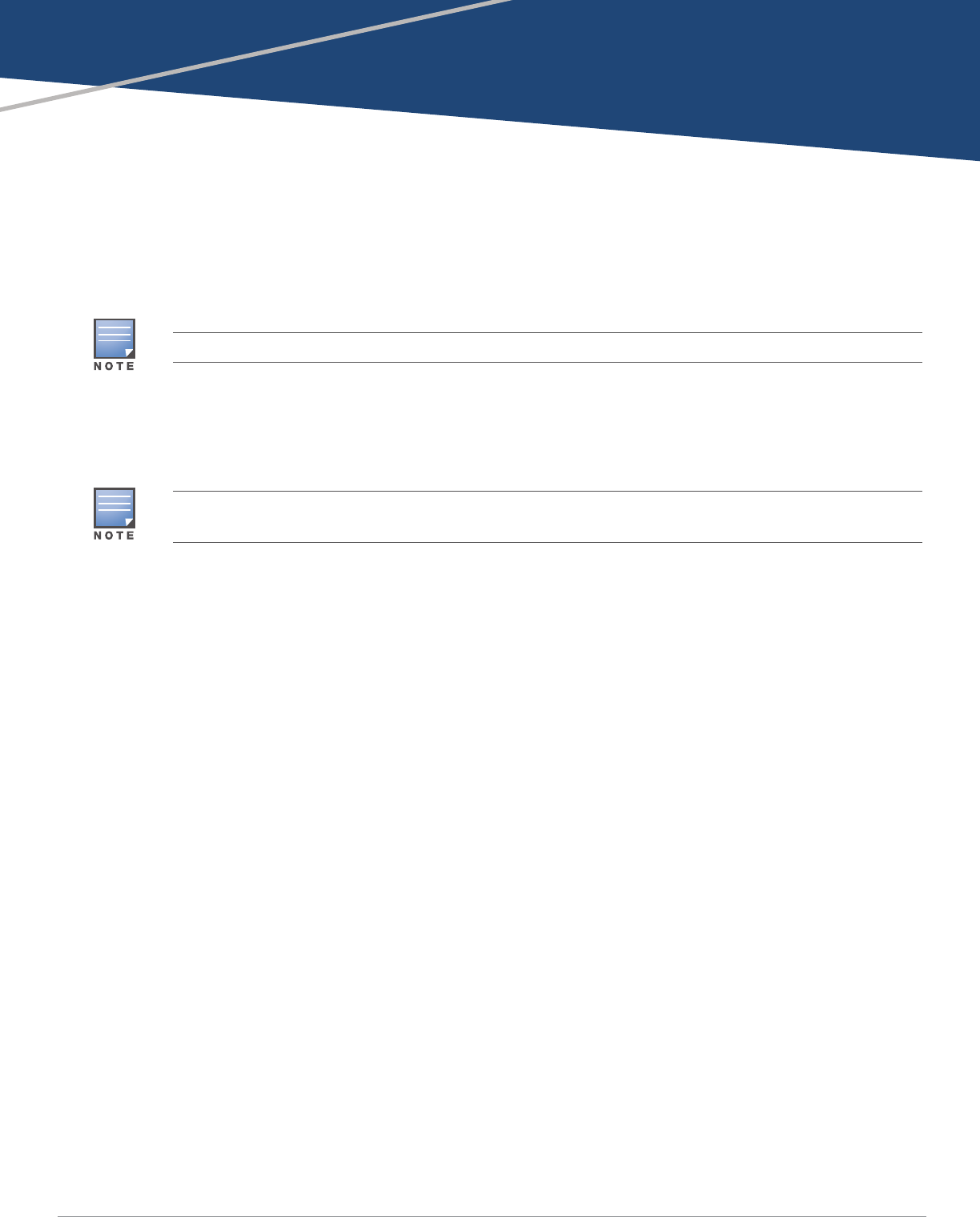
Aruba MSR4000 Wireless Mesh Router
Installation Guide
0511354-02 | July 2014 1
The Aruba AirMesh MSR4000 is a resilient, environmentally hardened, outdoor rated, four-radio, dual-band
IEEE 802.11 a/b/g/n wireless mesh router. This outdoor mesh router is part of Aruba’s comprehensive
wireless network solution. The MSR4000 delivers high-performance wireless mesh routing to outdoor
environments where wired connectivity is impractical or unavailable. The MSR4000 is ideal for deployment
in metropolitan and industrial areas, oil fields, mines, and shipping ports.
There are two versions of the MSR4000, which mainly differ in the way they receive power.
MSR4KP: Power over Ethernet (PoE+) powered
MSR4KAC: AC powered (100 - 240 VAC)
Guide Overview
"MSR4000 Hardware Overview" on page3 provides a detailed hardware overview of the two MSR4000
models.
"Outdoor Planning and Deployment Considerations" on page8 provides key questions to ask and items
to consider when deploying an outdoor wireless network.
"Weatherproofing Connections" on page12 provides instructions on weatherproofing the AP’s
connectors.
"Installing the MSR4000" on page20 describes the multi-step process for a successful installation and
deployment of an MSR4000.
"Safety and Regulatory Compliance" on page33 provides an overview of safety and regulatory
compliance information.
MSR4000 Operations
Wireless mesh router (IEEE 802.11 a/b/g/n)
MSR4KP: IEEE 802.3at Power over Ethernet+ (PoE+) compatible
MSR4KAC: IEEE 802.3af Power Sourcing Equipment (PSE) device
Package Contents
MSR4000 AirMesh Router
MSR4000 Mounting Bracket
Solar Shield
Pole Anchors x 4
The MSR4000 requires the Aruba MeshOS operating system.
The MSR4KAC can function as a Power Sourcing Equipment (PSE) device by providing power through its Ethernet
port in compliance with the IEEE 802.3af standard.
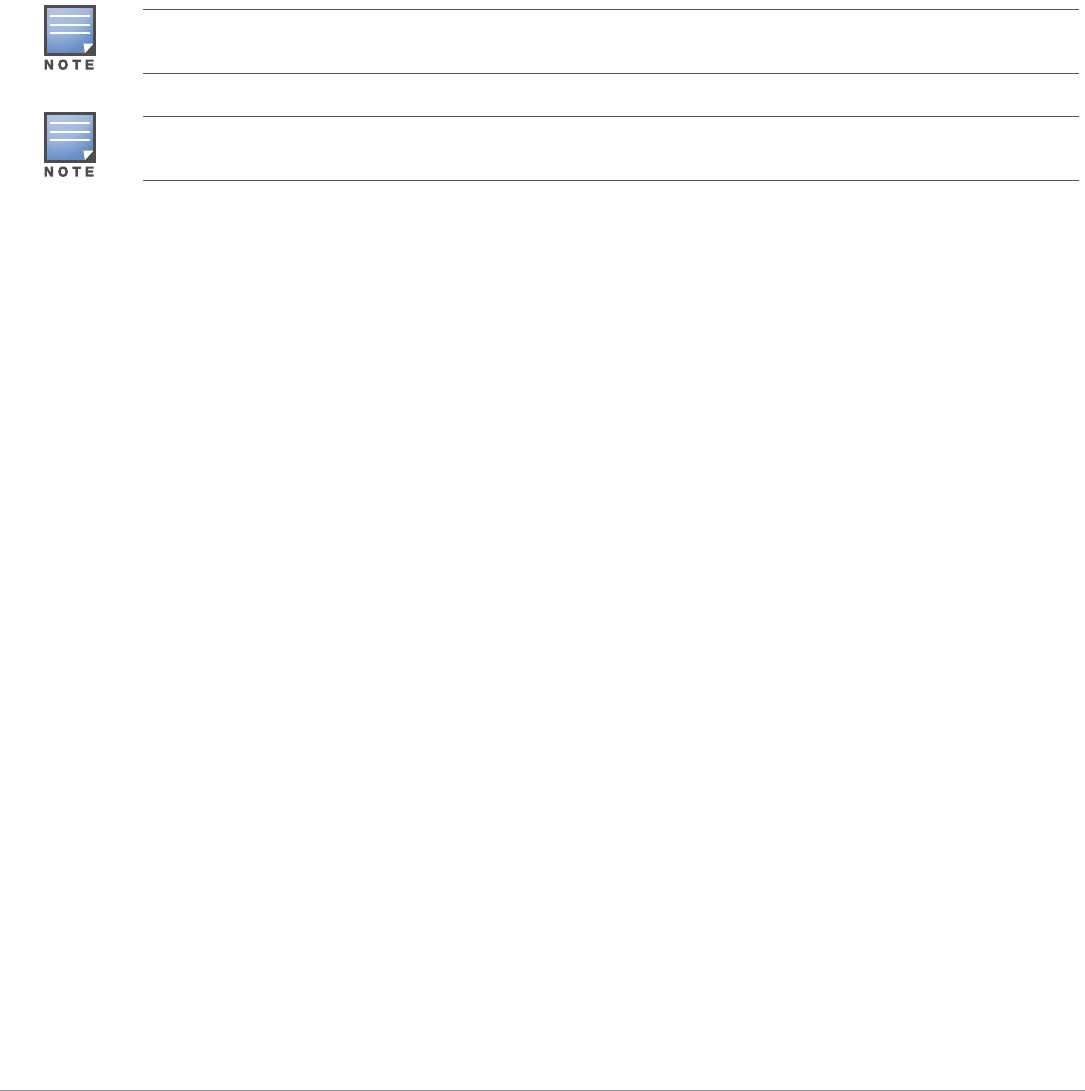
2Aruba MSR4000 Wireless Mesh Router | Installation Guide
M4 x 16 bolts, flat washers, and spring washers x4 (These bolts are attached to the solar shield)
M4 x 16 bolts, flat washers, and spring washers x2
M6 x 30 bolts, flat washers, and spring washers x2
M4 x 12 bolt, external-tooth washer, and OT copper lug x1
M8 x 110 bolt, flat washers, spring washers, and nuts x4
Metal Weatherproof Caps x2 for use on unused antenna interfaces
RJ-45 Connector Kit with metal RJ-45 connector
USB Console Cable
Installation Guide
Quick Start Guide
The MSR4000 does not ship with any power cables; these are available as accessories and should be ordered
separately.
Inform your supplier if there are any incorrect, missing, or damaged parts. If possible, retain the carton, including
the original packing materials. Use these materials to repack and return the unit to the supplier if needed.
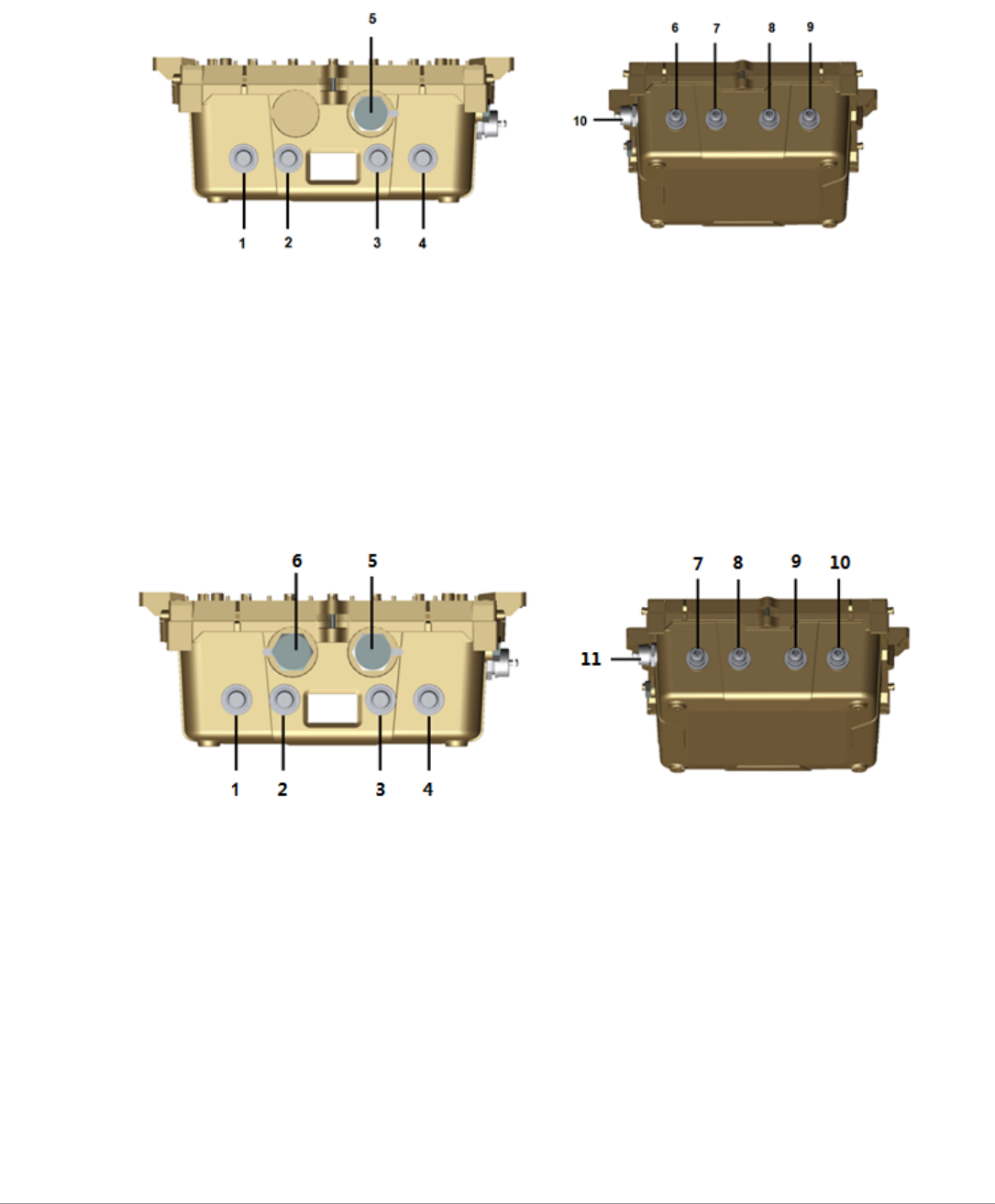
Aruba MSR4000 Wireless Mesh Router | Installation Guide 3
MSR4000 Hardware Overview
The following section describes the hardware features of the MSR4000.
Figure 1 MSR4KP Overview
Figure 2 MSR4KAC Overview
1 Antenna Interface 2 (Radio 2) 6 Antenna Interface 1 (Radio 0)
2 Antenna Interface 2 (Radio 1) 7 Antenna Interface 1 (Radio 3)
3 Antenna Interface 2 (Radio 3) 8 Antenna Interface 1 (Radio 1)
4 Antenna Interface 2 (Radio 0) 9 Antenna Interface 1 (Radio 2)
5 Ethernet Interface 10 USB Console Interface
1 Antenna Interface 2 (Radio 2) 7 Antenna Interface 1 (Radio 0)
2 Antenna Interface 2 (Radio 1) 8 Antenna Interface 1 (Radio 3)
3 Antenna Interface 2 (Radio 3) 9 Antenna Interface 1 (Radio 1)
4 Antenna Interface 2(Radio 0) 10 Antenna Interface 1 (Radio 2)
5 Ethernet Interface 11 USB Console Interface
6 AC Power Interface

4Aruba MSR4000 Wireless Mesh Router | Installation Guide
Antenna Interface
The MSR4000 requires the use of detachable outdoor-rated antennas. Select the correct antenna type to
support the required frequency band and the desired coverage pattern.
The MSR4000 is equipped with eight female N-type antenna interfaces; four on the top of the AP and four on
the bottom. The interfaces are grouped into diversity pairs, marked R0 (Radio 0), R1 (Radio 1), R2 (Radio 2)
and R3 (Radio 3).
USB Console Interface
A USB serial console port is provided for connection to a terminal, allowing direct local management. Use
the included USB console cable to connect to the AP. You can download the necessary driver for USB-
UART adapter from support.arubanetworks.com under the Tools & Resources tab.
Use the following setting to access the terminal:
The baudrate setting depends on the manufacturing date of the MSR4000 (before or after March 2012) and
the Serial Number (14 characters or 9 characters). The table above lists all the SKUs for this product along
with the corresponding baudrate.
Power Interface
The type of power interface on your MSR4000 depends on which model you have purchased.
MSR4KP: This version does not include a power interface since it is only powered by PoE+ (802.3at).
MSR4KAC: One AC power connector
Table 1 Console Settings
Product SKUs Serial Number Baud Rate Data Bits Parity Stop Bits Flow
Control
MSR4K43N0,
MSR4K43N0-JP,
MSR4K43N0-US,
MSR4K43N3,
MSR4K43N3-JP,
MSR4K43N3-US
14 characters
(For example:
26A02110500467)
115200 8 None 1 None
MSR4KP,
MSR4KP-JP,
MSR4KP-US
MSR4KP-IL
MSR4KAC,
MSR4KAC-JP,
MSR4KAC-US,
MSR4KAC-IL
9 characters
(For example:
AZ1234567)
9600 8 None 1 None
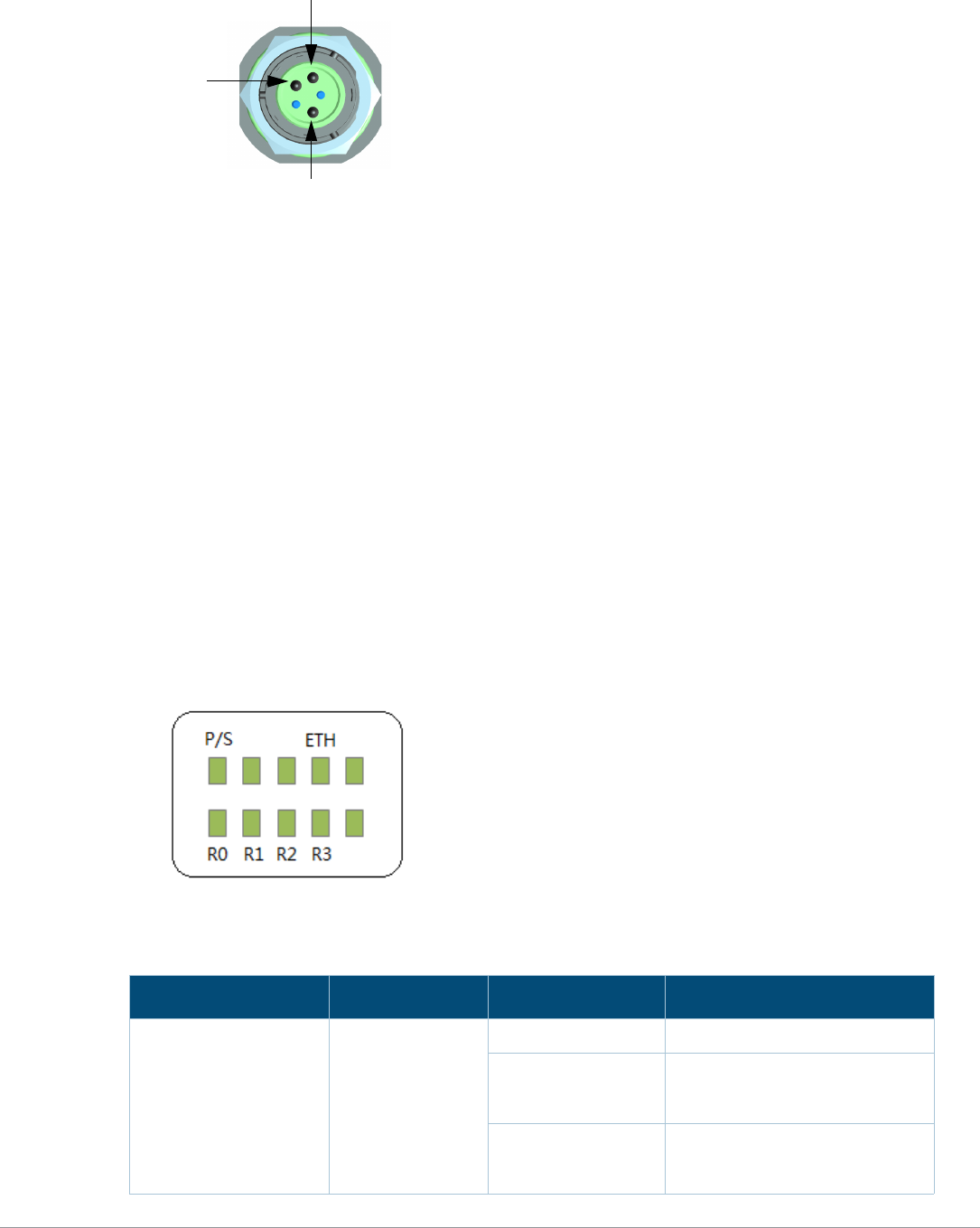
Aruba MSR4000 Wireless Mesh Router | Installation Guide 5
Figure 3 Power Interface on MSR4KAC
Ethernet Interface
The MSR4000 is equipped with a 10/100/1000Base-T Gigabit Ethernet port for wired network connectivity.
On the MSR4KP, this port also supports IEEE 802.3at Power over Ethernet (PoE), accepting 48 VDC as a
standards-defined powered device (PD) from a power sourcing equipment (PSE) device, such as a PoE
midspan injector. Inversely, the MSR4KAC can act as a PSE device to provide IEEE802.3af PoE power to
devices connected to the Ethernet port.
Grounding Point
Always remember to protect your MSR4000 by installing grounding lines. The ground connection must be
complete before connecting power to the MSR4000 enclosure. Ensure that the resistance is less than 5 ohm
between the ground termination point and the grounding tier and the cross section of the grounding cable
should be no less than 6 square mm.
MSR4KP LED Status Indicators
The MSR4000 include visual indicators for power, link, and radio status.
Figure 4 MSR4KP LED Layout
Table 2 lists the meanings of the LEDs on the MSR4KP outdoor mesh router.
Table 2 MSR4KP LED Status Indicators
LED Function Indicator Status
P/S Router Power/
Ready Status
Off No power to the router
On (Amber) Device has power but does not yet
have a mesh network routing path
to a gateway (portal) node
On (Green) Device has power and has found a
mesh network routing path to a
gateway (portal) node
Power Interface MSR4KAC
Neutral
Hot
Ground
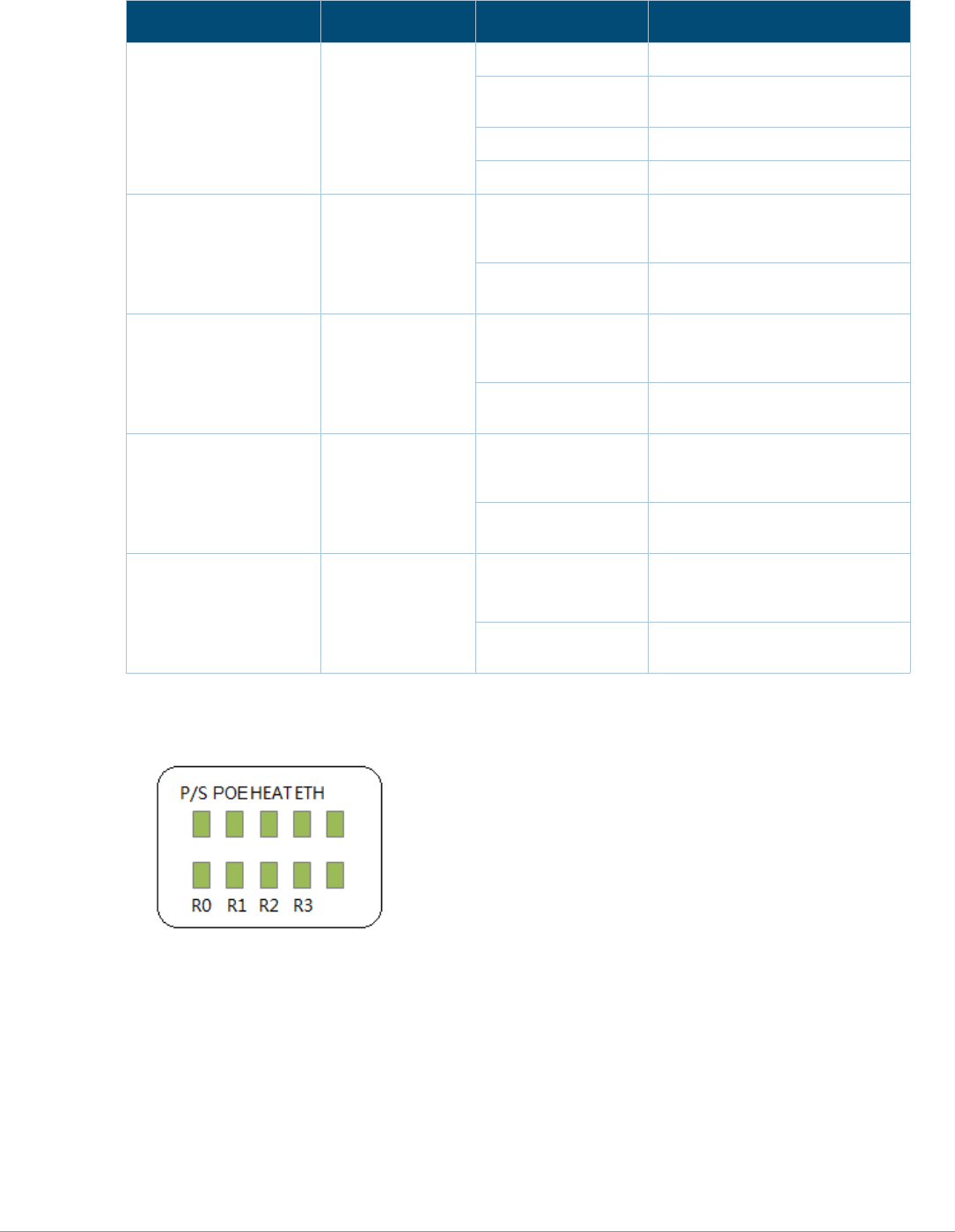
6Aruba MSR4000 Wireless Mesh Router | Installation Guide
MSR4KAC LED Status Indicators
Figure 5 MSR4KAC LED Layout
ENT LAN/Network Link
Status
Off Ethernet link unavailable
On (Amber) 10/100 Mbs Ethernet link
negotiated
On (Green) 1000 Mbs Ethernet link negotiated
Blinking Traffic on Ethernet link
R0 Radio 0 Status Off Radio 0 is not providing either
access (SSID) or backhaul (mesh)
service
On (Blue) Radio 0 is providing access (SSID)
service or backhaul (mesh) service
R1 Radio 1 Status Off Radio 1 is not providing either
access (SSID) or backhaul (mesh)
service
On (Blue) Radio 1 is providing access (SSID)
service or backhaul (mesh) service
R2 Radio 2 Status Off Radio 2 is not providing either
access (SSID) or backhaul (mesh)
service
On (Blue) Radio 2 is providing access (SSID)
service or backhaul (mesh) service
R3 Radio 3 Status Off Radio 3 is not providing either
access (SSID) or backhaul (mesh)
service
On (Blue) Radio 3 is providing access (SSID)
service or backhaul (mesh) service
Table 2 MSR4KP LED Status Indicators (Continued)
LED Function Indicator Status

Aruba MSR4000 Wireless Mesh Router | Installation Guide 7
Table 3 lists the meanings of the LEDs on the MSR4KAC outdoor mesh router.
Table 3 MSR4KAC LED Status Indicators
LED Function Indicator Status
P/S Router Power/
Ready Status
Off No power to the router
On (Amber) Device has power but does not yet
have a mesh network routing path
to a gateway (portal) node
On (Green) Device has power and has found a
mesh network routing path to a
gateway (portal) node
POE Displays PSE
power output
status
Off Non-powered device
(0Ω<Rport<200Ω) or Port open
(Rport>1MΩ)
Green Port on (25kΩ)
1 Flash: Low signature
resistance (300Ω<Rport<15kΩ)
2 Flashes: High signature
resistance
(33kΩ<Rport<500kΩ)
5 Flashes: Port overload fault
9 Flashes: Power management
allocation exceeded
HEAT Displays the
heating status of
low temperature
Off Unit is not in heating status
Blinking (Blue) Unit is pre-heating
ENT LAN/Network Link
Status
Off Ethernet link unavailable
On (Yellow) 10/100 Mbs Ethernet link
negotiated
On (Green) 1000 Mbs Ethernet link negotiated
Blinking Traffic on Ethernet link
R0 Radio 0 Status Off Radio 0 is not providing either
access (SSID) or backhaul (mesh)
service
On (Blue) Radio 0 is providing access (SSID)
service or backhaul (mesh) service
R1 Radio 1 Status Off Radio 1 is not providing either
access (SSID) or backhaul (mesh)
service
On (Blue) Radio 1 is providing access (SSID)
service or backhaul (mesh) service
R2 Radio 2 Status Off Radio 2 is not providing either
access (SSID) or backhaul (mesh)
service
On (Blue) Radio 2 is providing access (SSID)
service or backhaul (mesh) service
R3 Radio 3 Status Off Radio 3 is not providing either
access (SSID) or backhaul (mesh)
service
On (Blue) Radio 3 is providing access (SSID)
service or backhaul (mesh) service

8Aruba MSR4000 Wireless Mesh Router | Installation Guide
Outdoor Planning and Deployment Considerations
Prior to deploying an outdoor wireless network, the environment must be evaluated to plan for a successful
Aruba WLAN deployment. Successfully evaluating the environment enables the proper selection of Aruba
routers and antennas and assists in the determination of their placement for optimal RF coverage. This
process is considered WLAN or RF planning and Aruba’s system engineers can assist in the outdoor
planning process.
For WLAN systems being installed outdoors in the USA, the following requirements must be met.
1. Systems must be professionally installed by a qualified engineer familiar with WLAN, including Aruba
trained partners and resellers.
2. Operation in the 5600-5650-MHz band is prohibited.
3. When within 35 km distance of a TDWR, the center frequency of the WLAN must be separated from the
TDWR center frequency by 30 MHz.
a. If the radar is operating from 5600-5610 MHz, disable the use of channel 116 (5580 MHz).
b. If the radar is operating from 5630-5650 MHz, disable the use of channel 132 (5660 MHz).
For TWDR locations in the US please refer to www.wispa.org/tdwr-locations-and-frequencies.
Scale Requirements
The potentially immense scale of outdoor deployments requires consideration of factors that may not be as
important in a typical indoor deployment:
Range (distance): Range or distance between APs must be taken into account during the planning phase.
Available AP mounting locations are often far less flexible in an outdoor environment. Regardless of
these outdoor restrictions, the desired goal is to achieve results similar to an indoor deployment: a
“dense” RF deployment that supports advanced Aruba features, such as efficient client roaming, and
failover.
Elevation: Proper consideration and planning for elevation differences between routers (router to
router) and AP to Client can be critical to success. To plan for these differences in elevation, it is
important to understand the 3D coverage pattern provided by the antennas that will be deployed in the
environment.
Non-Fixed Considerations: The RF environment might change on a day to day basis. Keep non-fixed
items, such as shipping containers, vehicles, and future building construction, in mind when planning for
an outdoor deployment.
Identifying Known RF Scatterers/Reflectors/Interferences Sources
Identifying known RF scatterers/reflectors/interference sources while out in the field during the installation
phase is critical. Even though outdoor environments consist of fewer RF scatterers/reflectors/interference
sources compared to indoor environments, ensure that these sources are identified and taken into
consideration when installing and mounting a router to its fixed outdoor location.
Starting with MeshOS 4.5, you can turn off the LEDs in the MSR4000 devices using the WMI and CLI. The LEDs are
enabled by default. This option may be used to disable the LED lights in a MSR4000 device that is mounted in an
elevated place on the city streets or residential areas, to avoid unwanted attention or disturbance. This feature turns
off only the LED lights that indicate the software status, for example the RF. The LEDs that indicate the hardware
status, for example Power, P/S, POE, and ETH, cannot be turned off using this feature. For additional details, refer
to the Aruba MeshOS User Guide and the Aruba MeshOS Command Reference Guide.
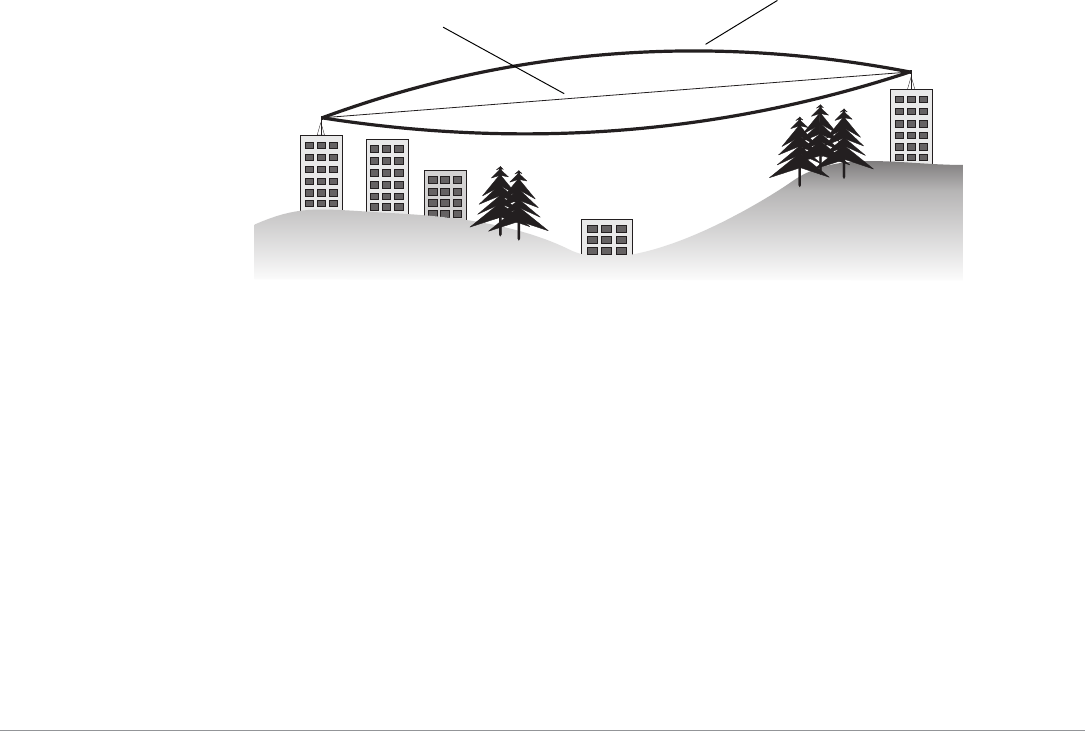
Aruba MSR4000 Wireless Mesh Router | Installation Guide 9
RF Scatterers
Cement/Concrete
Natural Items: Trees/vegetation
Brick
RF Reflectors
Metal Objects: Roof-installed air-conditioning equipment, chain link fences (depending on aperture
size), other wire fences, or water pipes
RF Interference Sources
Other 802.11a/b/g/n or broadband access equipment operating nearby
Industrial RF welding equipment or other Industrial, Scientific and Medical (ISM) equipment that utilizes
RF to heat or alter the physical properties of materials
Military, Commercial Aviation or Weather Radar Systems
Line of Sight (Radio Path Planning)
A wireless bridge or mesh link requires a “radio line of sight” between the two antennas for optimum
performance. The concept of radio line of sight involves the area along a link through which the bulk of the
radio signal power travels. This area is known as the first Fresnel Zone of the radio link. For a radio link, no
object (including the ground) must intrude within 60% of the first Fresnel Zone.
Figure 6 illustrates the concept of a good radio line of sight.
Figure 6 Line of Sight
If there are obstacles in the radio path, there may still be a radio link but the quality and strength of the
signal will be affected. Calculating the maximum clearance from objects on a path is important as it directly
affects the decision on antenna placement and height. It is especially critical for long-distance links, where
the radio signal could easily be lost.
When planning the radio path for a wireless bridge or mesh link, consider these factors:
Avoid any partial line of sight between the antennas
Be cautious of trees or other foliage that may be near the path, or may grow and obstruct the path.
Be sure there is enough clearance from buildings and that no building construction may eventually block
the path.
For very long distance links, the curvature of the earth (20 cm per km) may need to be considered in the
calculation of relative heights.
Radio Line of Sight
Visual Line of Sight
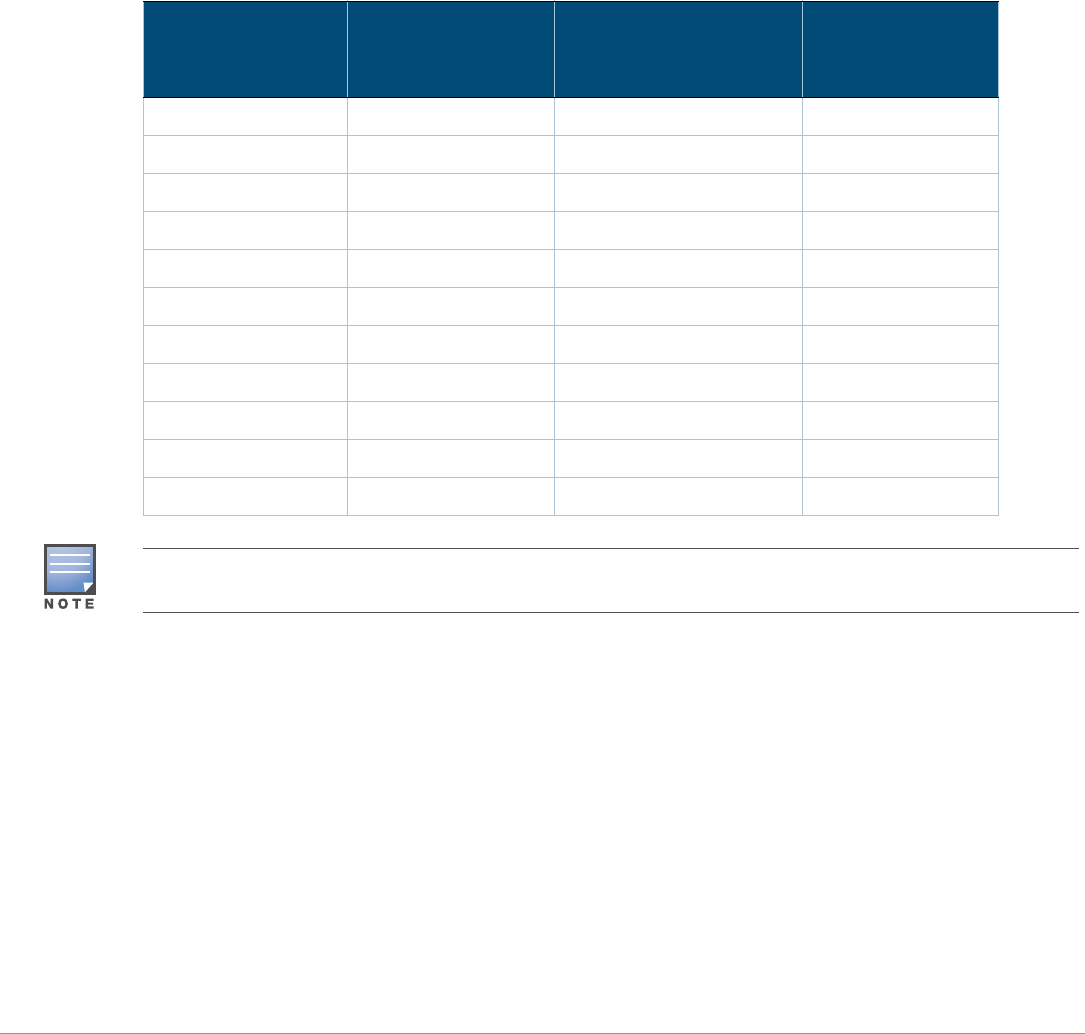
10 Aruba MSR4000 Wireless Mesh Router | Installation Guide
Check the topology of the land between the antennas using topographical maps, aerial photos, or even
satellite image data (software packages are available that may include this information for your area)
Avoid a path that may incur temporary blockage due to the movement of cars, trains, or aircraft.
Antenna Height
A reliable wireless bridge or mesh link is usually best achieved by mounting the antennas at each end high
enough for a clear radio line of sight between them. The minimum height required depends on the distance
of the link, obstacles that may be in the path, topology of the terrain, and the curvature of the earth (for
links over 3 miles).
For long-distance links, the router may have to be mounted on masts or poles that are tall enough to attain
the minimum required clearance. Use the following table to estimate the required minimum clearance
above the ground or path obstruction (for 5 GHz bridge links).
Table 4 Antenna Minimum Height and Clearance Requirements
Total Link Distance
Max Clearance for
60% of First Fresnel
Zone at 5.8 GHz
Approximate Clearance
for Earth Curvature
Total Clearance
Required at
Mid-point of Link
0.25 mile (0.402 km) 4.6 ft (1.4 m) 0.007 ft (0.002 m) 4.6 ft (1.4 m)
0.5 mile (0.805 km) 6.2 ft (1.9 m) 0.03 ft (0.010 m) 6.2 ft (1.9 m)
1 mile (1.6 km) 8.9 ft (2.7 m) 0.13 ft (0.04 m) 8.9 ft (2.7 m)
2 miles (3.2 km) 12.5 ft (3.8 m) 0.5 ft (0.15 m) 13.1 ft (4.0 m)
3 miles (4.8 km) 15.4 ft (4.7 m) 1.0 ft (0.3 m) 16.4 ft (5.0 m)
4 miles (6.4 km) 17.7 ft (5.4 m) 2.0 ft (0.6 m) 19.7 ft (6.0 m)
5 miles (8 km) 20 ft (6.1 m) 3.0 ft (0.9 m) 23 ft (7.0 m)
7 miles (11.3 km) 23.6 ft (7.2 m) 6.2 ft (1.9 m) 30 ft (9.1 m)
9 miles (14.5 km) 27 ft (8.2 m) 10.2 ft (3.1 m) 37 ft (11.3 m)
12 miles (19.3 km) 30.8 ft (9.4 m) 18.0 ft (5.5 m) 49 ft (14.9 m)
15 miles (24.1 km) 34.4 ft (10.5 m) 28.0 ft (8.5 m) 62.7 ft (19.1 m)
To avoid any obstruction along the path, the height of the object must be added to the minimum clearance required
for a clear radio line of sight. Consider the following simple example, illustrated in Figure 7.
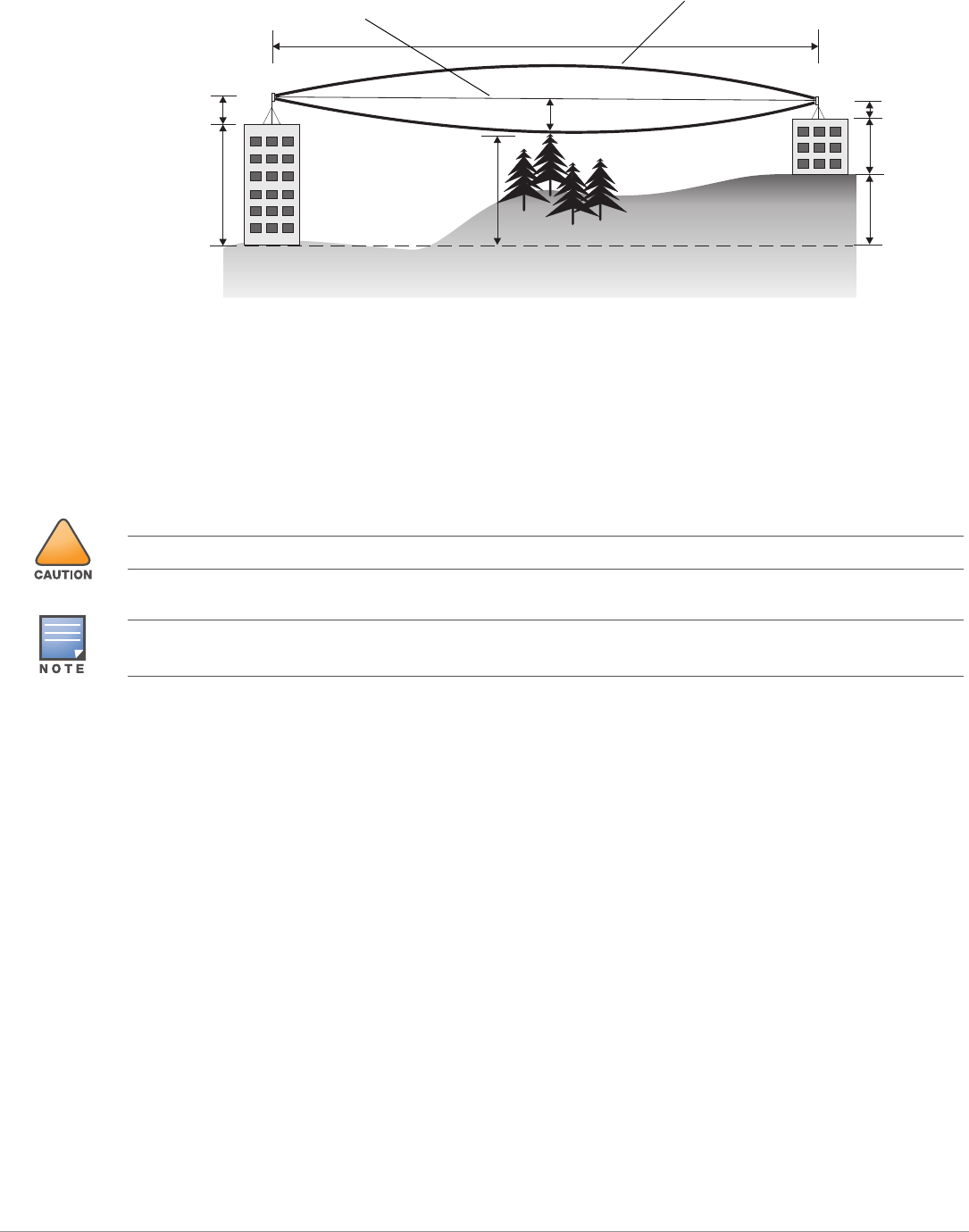
Aruba MSR4000 Wireless Mesh Router | Installation Guide 11
Figure 7 Antenna Height and Line of Sight
A wireless bridge or mesh link is deployed to connect building A to building B, which is located three miles
(4.8 km) away. Mid-way between the two buildings is a small tree-covered hill. From the above table it can
be seen that for a three-mile link, the object clearance required at the mid-point is 5.3 m (17.4 ft). The tree
tops on the hill are at an elevation of 17 m (56 ft), so the antennas at each end of the link need to be at least
22.3 m (73 ft) high. Building A is six stories high, or 20 m (66 ft), so a 2.3 m (7.5 ft) mast or pole must be
constructed on its roof to achieve the required antenna height. Building B is only three stories high, or 9 m
(30 ft), but is located at an elevation that is 12 m (39 ft) higher than building A. To mount an antenna at the
required height on building B, a mast or pole of 1.3 m (4.3 ft) is needed.
Antenna Position and Orientation
Once the required antenna height has been determined, other factors affecting the precise position of the
wireless bridge or mesh link must be considered:
Be sure there are no other radio antennas within 2 m (6 ft) of the wireless bridge or mesh link. These
include other WiFi radio antennas.
Place the wireless bridge or mesh link away from power and telephone lines.
Avoid placing the wireless bridge or mesh link too close to any metallic reflective surfaces, such as roof-
installed air-conditioning equipment, tinted windows, wire fences, or water pipes. Ensure that there is at
least 5 feet clearance from such objects.
The wireless bridge or mesh link antennas at both ends of the link must be positioned with the same
polarization direction, either horizontal or vertical. Proper alignment helps to maximize throughput.
Radio Interference
The avoidance of radio interference is an important part of wireless link planning. Interference is caused by
other radio transmissions using the same or an adjacent channel frequency. You should first scan your
proposed site using a spectrum analyzer to determine if there are any strong radio signals using the 802.11a/
b/g channel frequencies. Always use a channel frequency that is furthest away from another signal.
AB
3 miles (4.8 km)
5.4 m
17 m
20 m
2.4 m
12 m
9m
1.4 m
Radio Line of Sight
Visual Line of Sight
!
Never construct a radio mast, pole, or tower near overhead power lines.
Local regulations may limit or prevent construction of a high radio mast or tower. If your wireless bridge or mesh link
requires a high radio mast or tower, consult a professional contractor for advice.
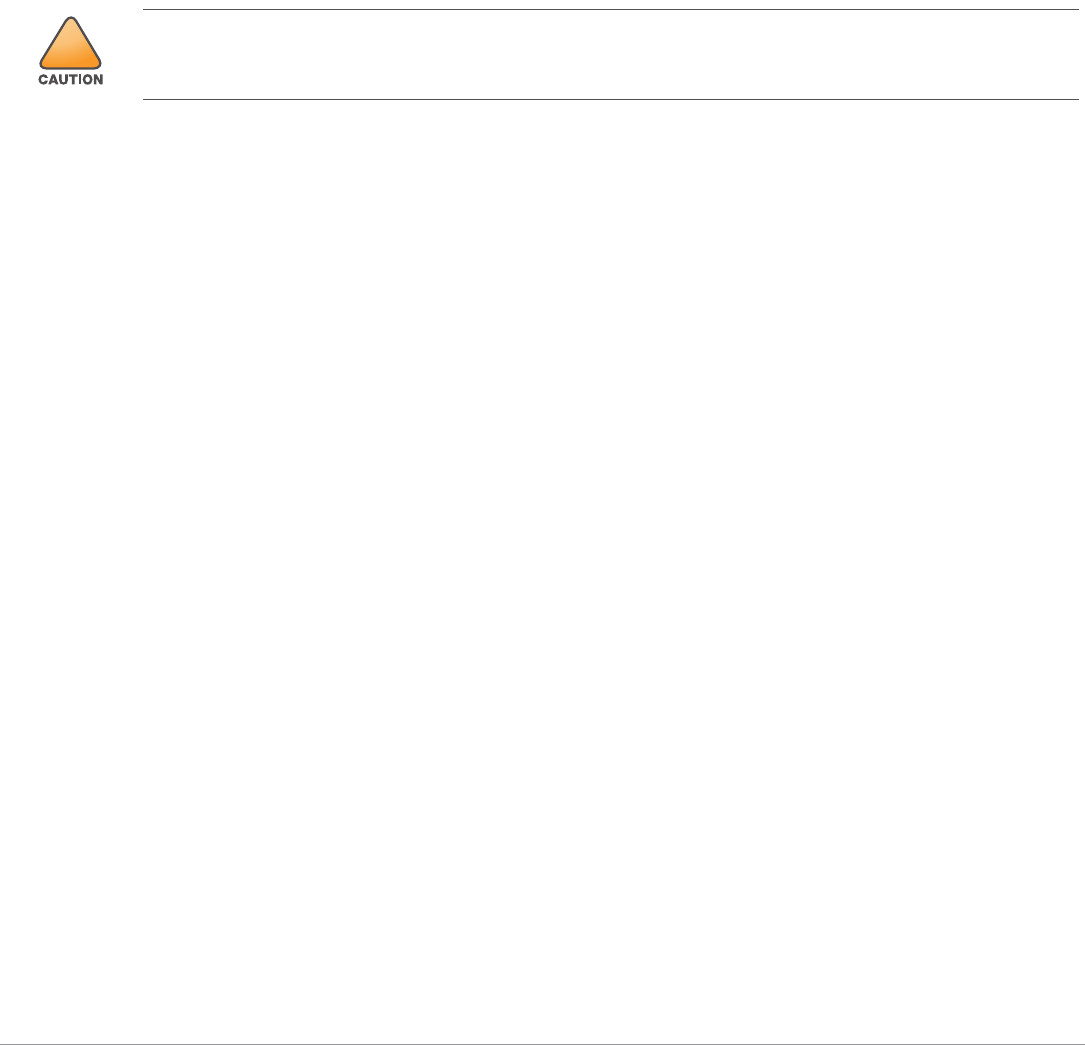
12 Aruba MSR4000 Wireless Mesh Router | Installation Guide
If radio interference is still a problem with your wireless bridge or mesh link, changing the antenna
direction may improve the situation.
Weather Conditions
When planning wireless bridge or mesh links, you must take into account any extreme weather conditions
that are known to affect your location. Consider these factors:
Temperature: The wireless bridge or mesh link is tested for normal operation in temperatures from -30ºC
to 55ºC. Operating in temperatures outside of this range may cause the unit to fail.
Wind Velocity: The wireless bridge or mesh link can operate in winds up to 165 miles per hour. You must
consider the known maximum wind velocity and direction at the site and be sure that any supporting
structure, such as a pole, mast, or tower, is built to withstand this force.
Lightning: To protect against lightning induced surges, the MSR2000 requires lightning protection on the
radio interface ports.
Rain: The wireless bridge or mesh link is weatherproofed against rain. However, it is recommended to
apply weatherproof sealing tape around the Ethernet port and antenna connectors for extra protection.
If moisture enters a connector, it may cause a degradation in performance or even a complete failure of
the link.
Snow and Ice: Falling snow, like rain, has no significant effect on the radio signal. However, a buildup of
snow or ice on antennas may cause the link to fail. In this case, the snow or ice has to be cleared from
the antennas to restore operation of the link.
Ethernet Cabling
When a suitable antenna location has been determined, you must plan a cable route from the wireless
bridge or mesh link outdoors to a suitable power and/or network source.
Consider these points:
The Ethernet cable length should never be longer than 90 m (295 ft).
Determine a building entry point for the cable (if applicable).
Determine if conduits, bracing, or other structures are required for safety or protection of the cable.
For lightning protection at the power injector end of the cable, consider using a lightning arrestor
immediately before the cable enters the building
Grounding
It is important that the wireless bridge or mesh link, cables, and any supporting structures are properly
grounded. Each MSR4000 access point includes a grounding screw for attaching a ground wire. Be sure that
grounding is available and that it meets local and national electrical codes. Ground the access point first
using the external ground stud on the unit before making any other connection.
Weatherproofing Connections
!
An Aruba Lightning Arrestor, AP-LAR-1, must be installed on each antenna port for protection against lightning
induced surges. Failure to use an AP-LAR-1 can void the warranty of an Aruba outdoor AP model and renders the
AP susceptible to failure from lightning induced surges
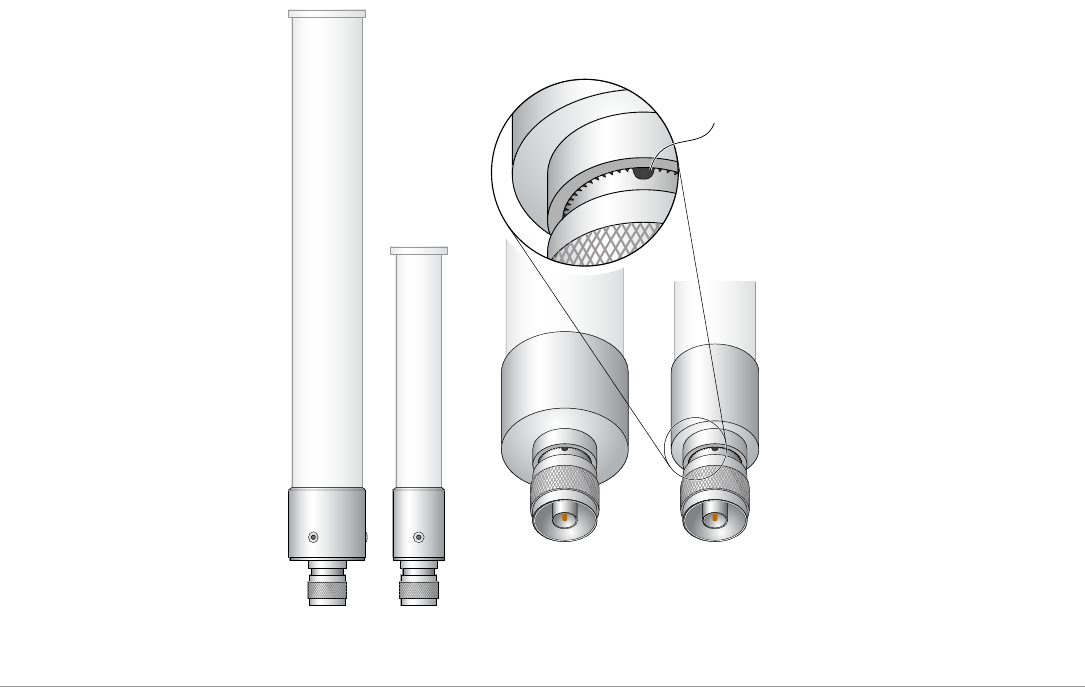
Aruba MSR4000 Wireless Mesh Router | Installation Guide 13
Weatherproofing your antenna and/or cable connections on your outdoor router is essential to reliability
and longevity of your product. This process prevents water from entering the router or antennas through
the connectors.
A good weatherproofing job consists of three wrappings:
1. electrical tape
2. butyl rubber
3. electrical tape
The first wrapping of tape should be at least two layers, followed by a single wrap of butyl rubber, and four-
layer wrap of electrical tape. This provides good protection from water, heat, and other potential hazards
that could damage your router or antennas.
Additionally, wrap your connections such that water is always directed down and away from connections.
Required Items and Tools
3/4” (19 mm) Vinyl Electrical Tape
Butyl Rubber Tape
Knife or Box Cutter
Types of Connections
The following sections provide guidance on weatherproofing directly connected antennas (Figure 8) and
cable connections (Figure 9). The same materials are needed for weatherproofing both types of
connections but the procedure is slightly different. For weatherproofing directly connected antennas, see
"Weatherproofing Directly Connected Antennas" on page15. For weatherproofing cable connections, see
"Weatherproofing Cable Connections" on page18.
Figure 8 Directly Connected Antennas
AP175_11
Weep holes
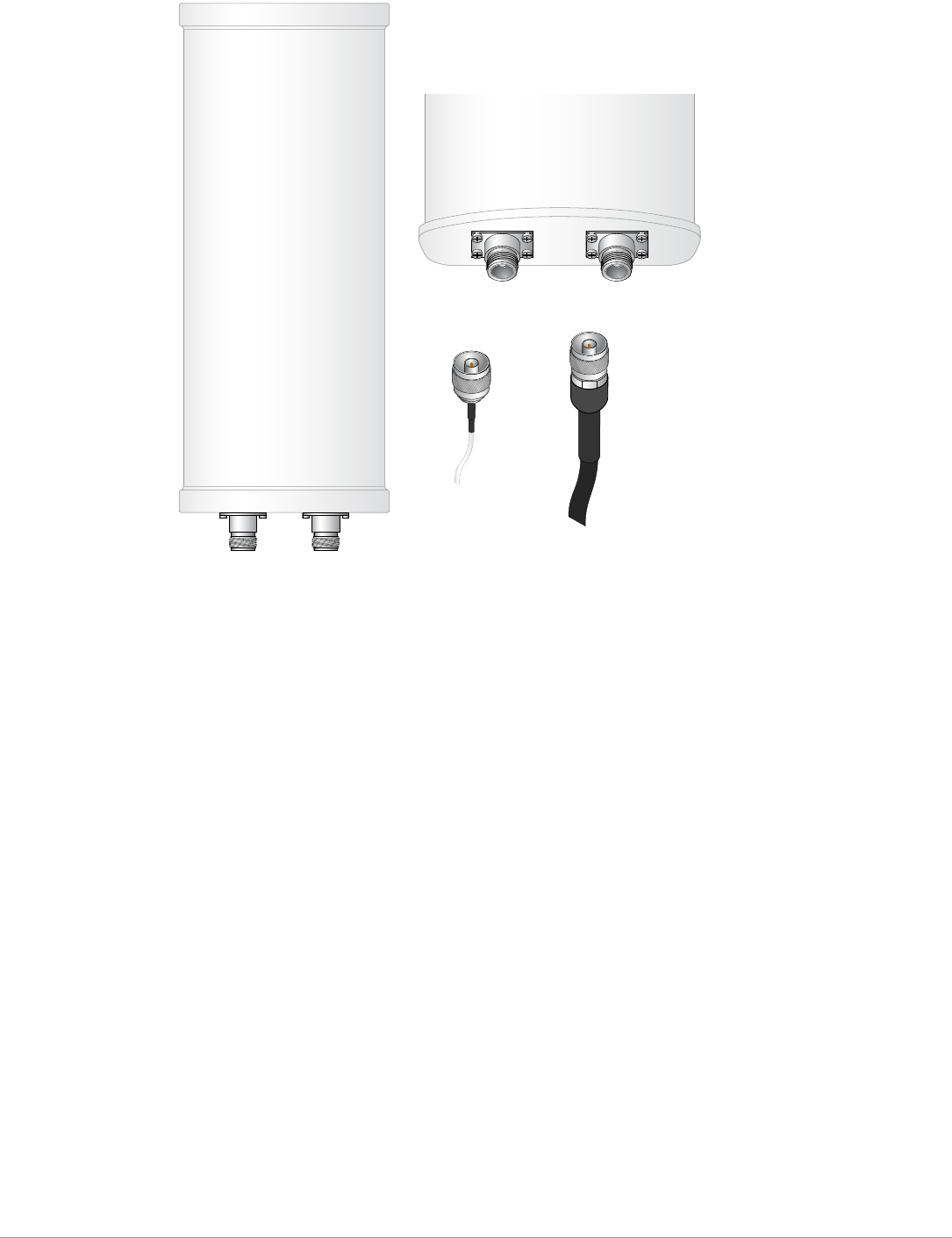
14 Aruba MSR4000 Wireless Mesh Router | Installation Guide
Figure 9 Cable Connections
Important Points to Remember
Do not cover the weep holes on the antennas. Doing so can restrict the release of condensation from the
antennas.
Proper weatherproofing is not a fast process. Set aside ample time to complete the steps outlined below.
When wrapping, make the each layer of tape as flat as possible. Wrinkles and folds in the tape create
places for water and moisture to gather.
AP175_16
Connectors on bottom of antenna
N-type connector
on an RF cable
N-type
connector
on a pigtail
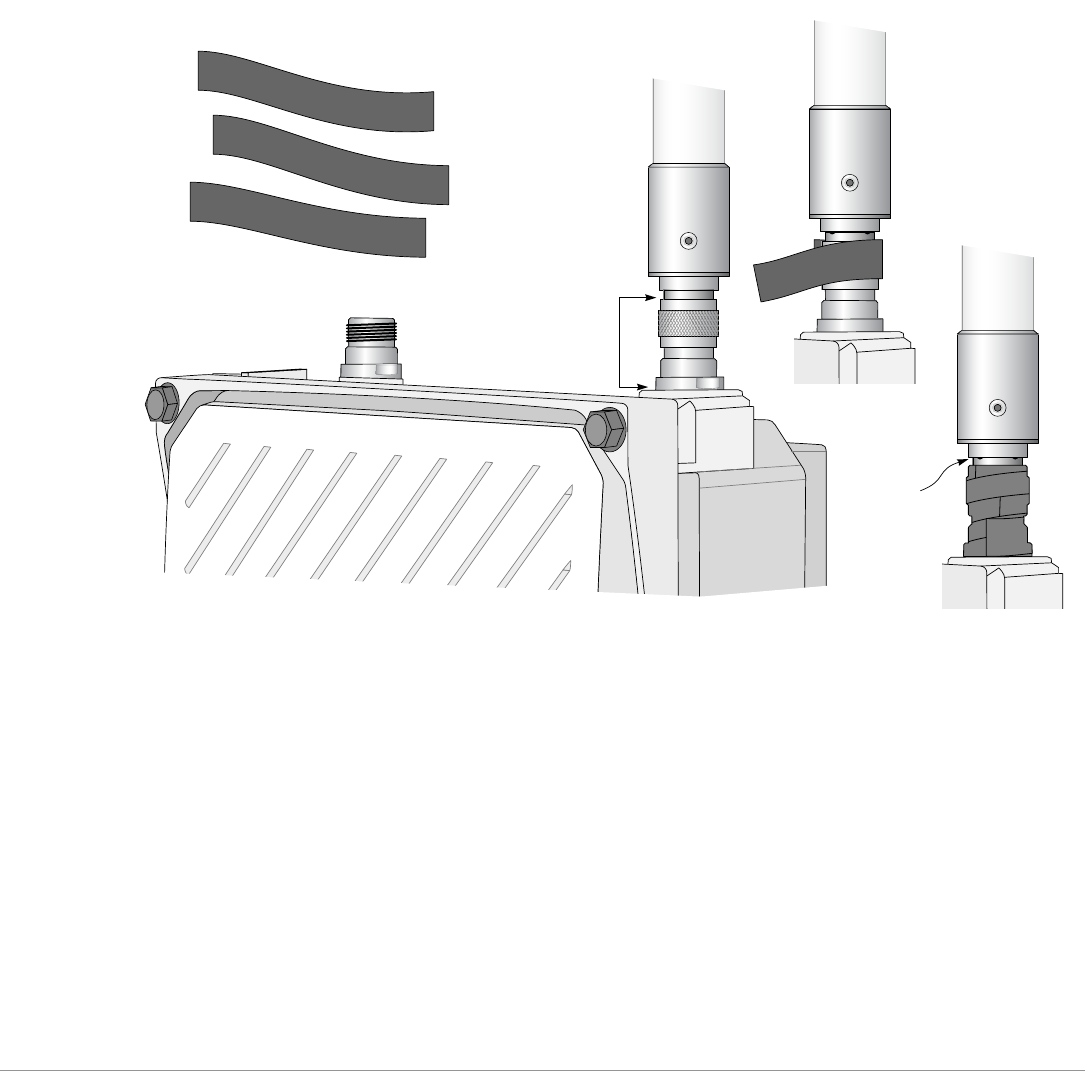
Aruba MSR4000 Wireless Mesh Router | Installation Guide 15
Weatherproofing Directly Connected Antennas
First Wrapping of Tape
1. Before wrapping the antennas, locate the weep holes (Figure 6). Weep holes allow condensation that
has built up inside the antenna to escape.
2. Prepare the antenna connector by cleaning and drying it.
3. Cut a 4” (100 mm) strip of electrical tape from the roll. Pre-cutting the tape into strips makes in easier to
maneuver the tape around the antennas and other components of the router’s case.
4. Beginning just below the weep holes, tightly wrap the connection with a layer of the 3/4” (19mm)
electrical tape. Overlap the tape to a half-width.
5. Repeat steps 3 and 4 until the wrapping extends all the way to the router’s case.
Figure 10 First Wrapping of Tape
Wrap tape from
just above knurled
section to base of
antenna mount
Pieces of tape as needed
Leave
weep holes
uncovered
AP175_12

16 Aruba MSR4000 Wireless Mesh Router | Installation Guide
Wrapping of Butyl Rubber
1. Cut a 3/4” (19 mm) strip of butyl rubber.
2. Wrap the strip of rubber around the taped connector (Figure 11)
3. Join the two ends by pushing them together until there is no longer a seam (Figure 12).
Figure 11 Butyl Rubber Placement
Figure 12 Butyl Rubber Wrap
Cut 3/4” strip
of rubber
Squeeze thinner
& wider Wrap rubber
around base
of antenna
mount
AP175_13
Wrap rubber
around base
of antenna
mount
Squeeze to
bond rubber
to itself
Rubber will
be wrapped
with 4 layers
of tape
AP175_14
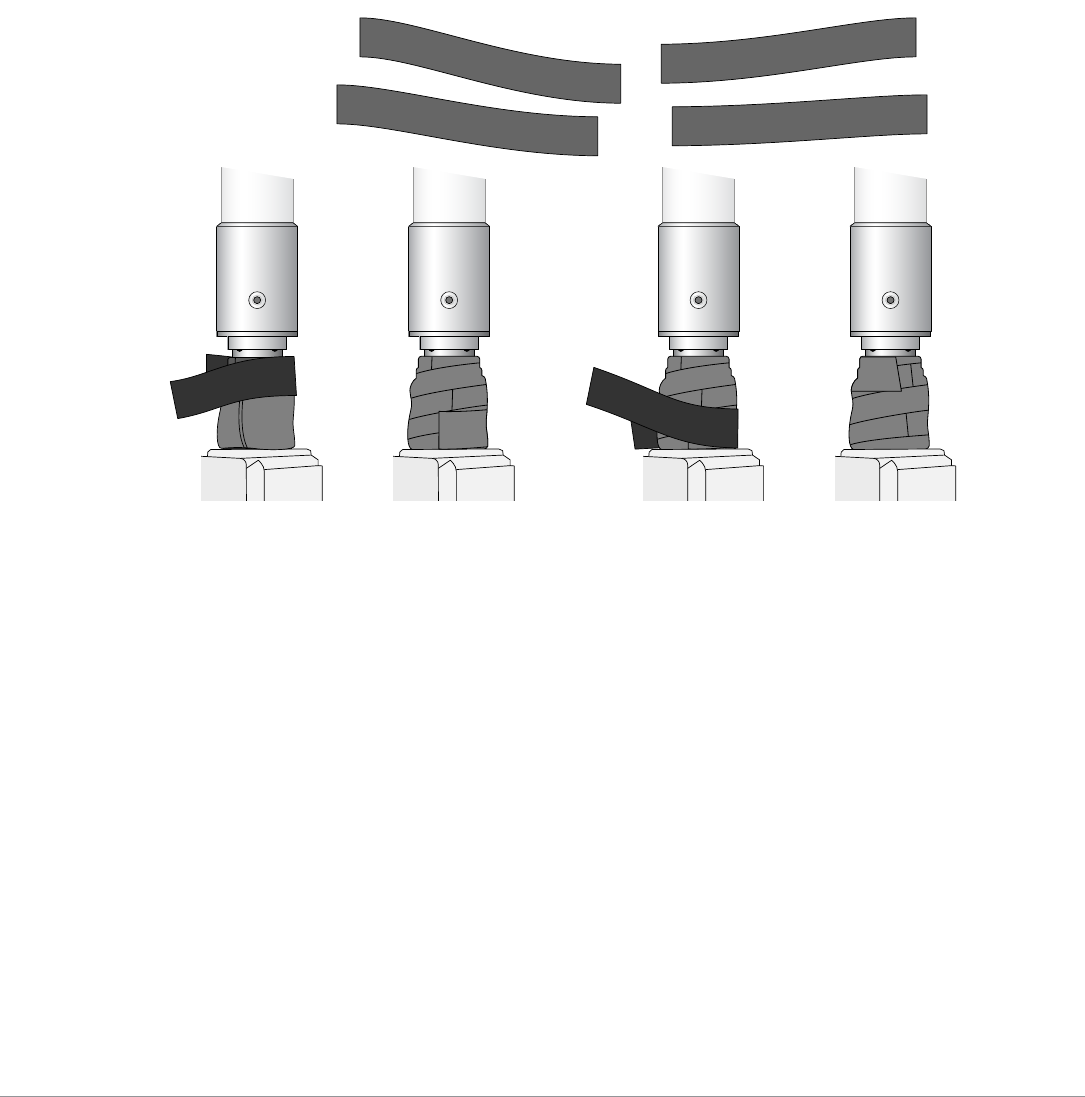
Aruba MSR4000 Wireless Mesh Router | Installation Guide 17
Second Wrapping of Tape
1. Cut a 4” (100 mm) strip of electrical tape from the roll.
2. Where you begin wrapping depends on the orientation of the antenna. Water should flow in the opposite
direction of the wrapping to prevent water from entering the connector between the layers of tape.
Therefore, if the antenna is facing up, you should begin wrapping at the router end of the connector. This
will ensure that your fourth and final layer will be layered correctly. Conversely, if your antenna is facing
down, you should begin wrapping on the antenna end of the connector.
3. After completing the fourth layer of tape, check your work to ensure there are no places where water
can collect. If there are, you must smooth out those areas with additional layers of tape or remove the
weatherproofing and begin again.
Figure 13 Completed Wrapping (Antenna on Top of router)
4. Repeat this process for all connectors.
First and third layers wrap
top to bottom
AP175_15
Rubber will
be wrapped
with 4 layers
of tape
Second and final layers wrap
bottom to top
Pieces of tape as needed
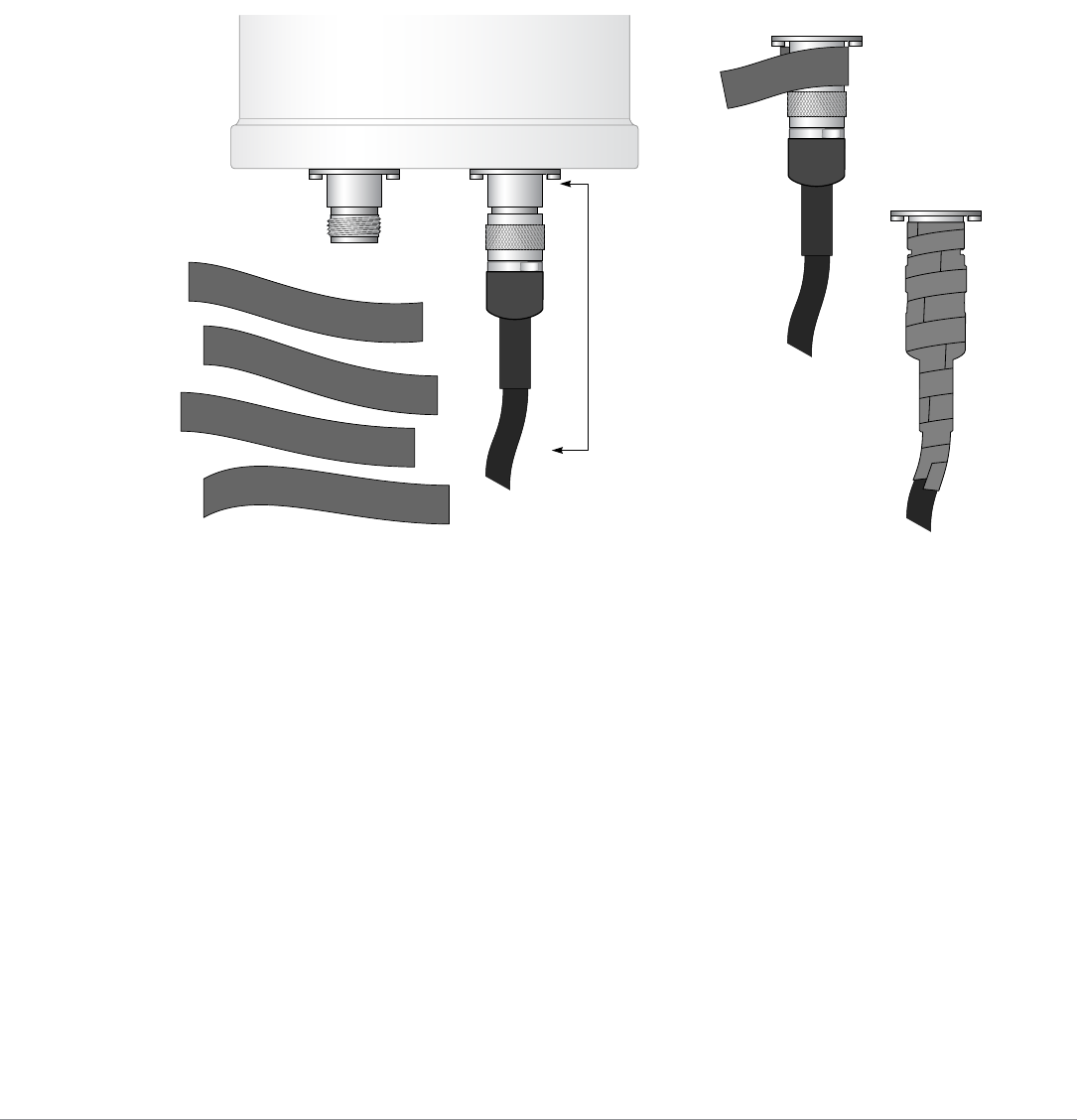
18 Aruba MSR4000 Wireless Mesh Router | Installation Guide
Weatherproofing Cable Connections
First Wrapping of Tape
1. Prepare the antenna connector by cleaning and drying it.
2. Cut a 4” (100 mm) strip of electrical tape from the roll. Pre-cutting the tape into strips makes in easier to
maneuver the tape around the connectors and other components but is not required.
3. Beginning at the top of the connector, tightly wrap the connection with a layer of the 3/4” (19mm)
electrical tape. Overlap the tape to a half-width.
4. Repeat steps 3 and 4 until the wrapping extends all the way to the cable’s insulation.
Figure 14 First Wrapping of Tape
Wrap tape
from antenna
connector base
to cable
Pieces of tape as needed
AP175_17
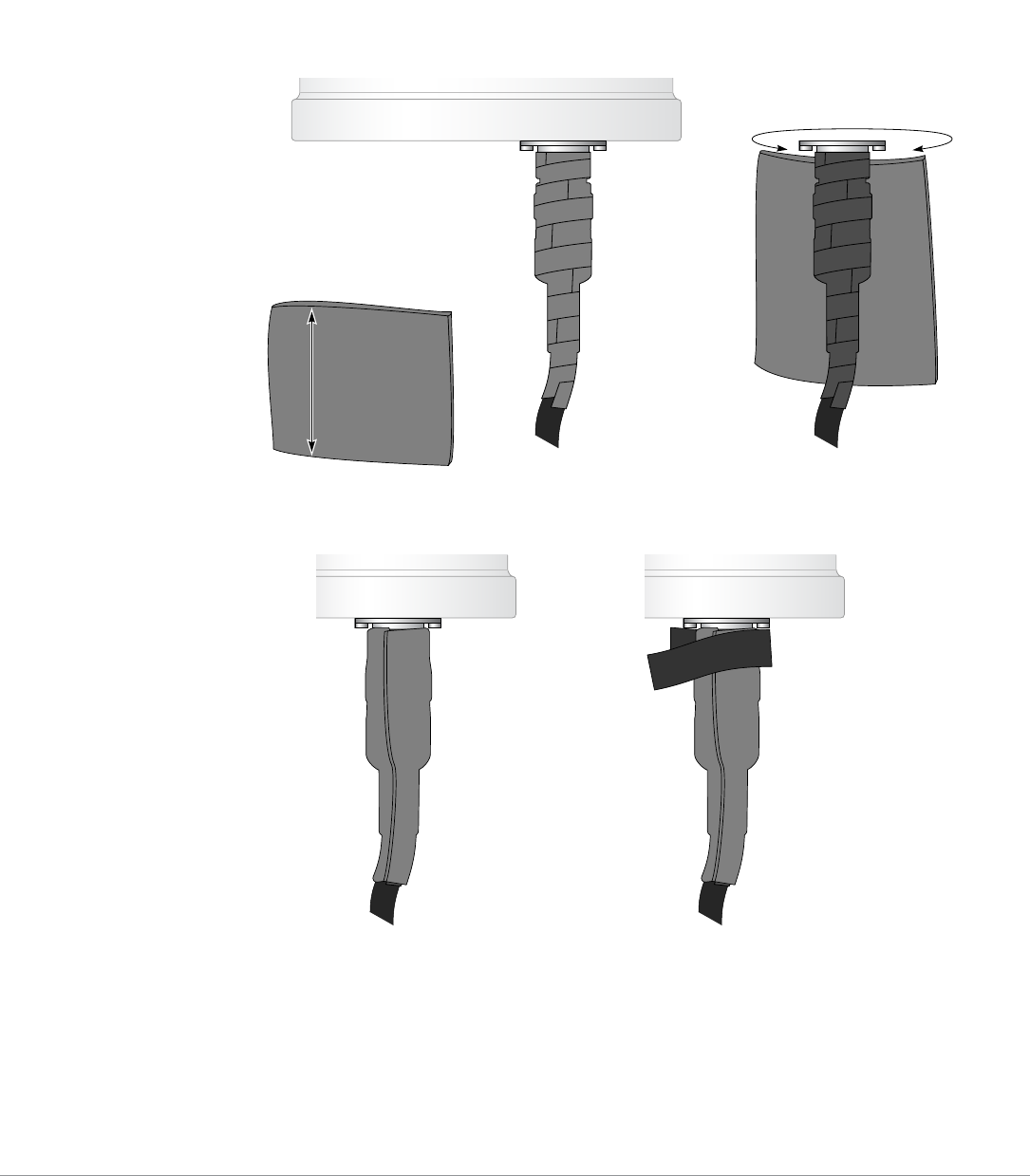
Aruba MSR4000 Wireless Mesh Router | Installation Guide 19
Wrapping of Butyl Rubber
1. Cut a piece of butyl rubber large enough to wrap around the connector and extended past the first layer
of tape.
2. Wrap the strip of rubber around the taped connector (Figure 15)
3. Join the two ends by pushing them together until there is no longer a seam (Figure 16).
Figure 15 Butyl Rubber Placement
Figure 16 Butyl Rubber Wrap
Stretch thinner
& wider
AP175_18
Wrap rubber
around connector
and cable
Squeeze to
bond rubber
to itself
Rubber will
be wrapped
with 4 layers
of tape
AP175_19
Wrap rubber
around connector
and cable
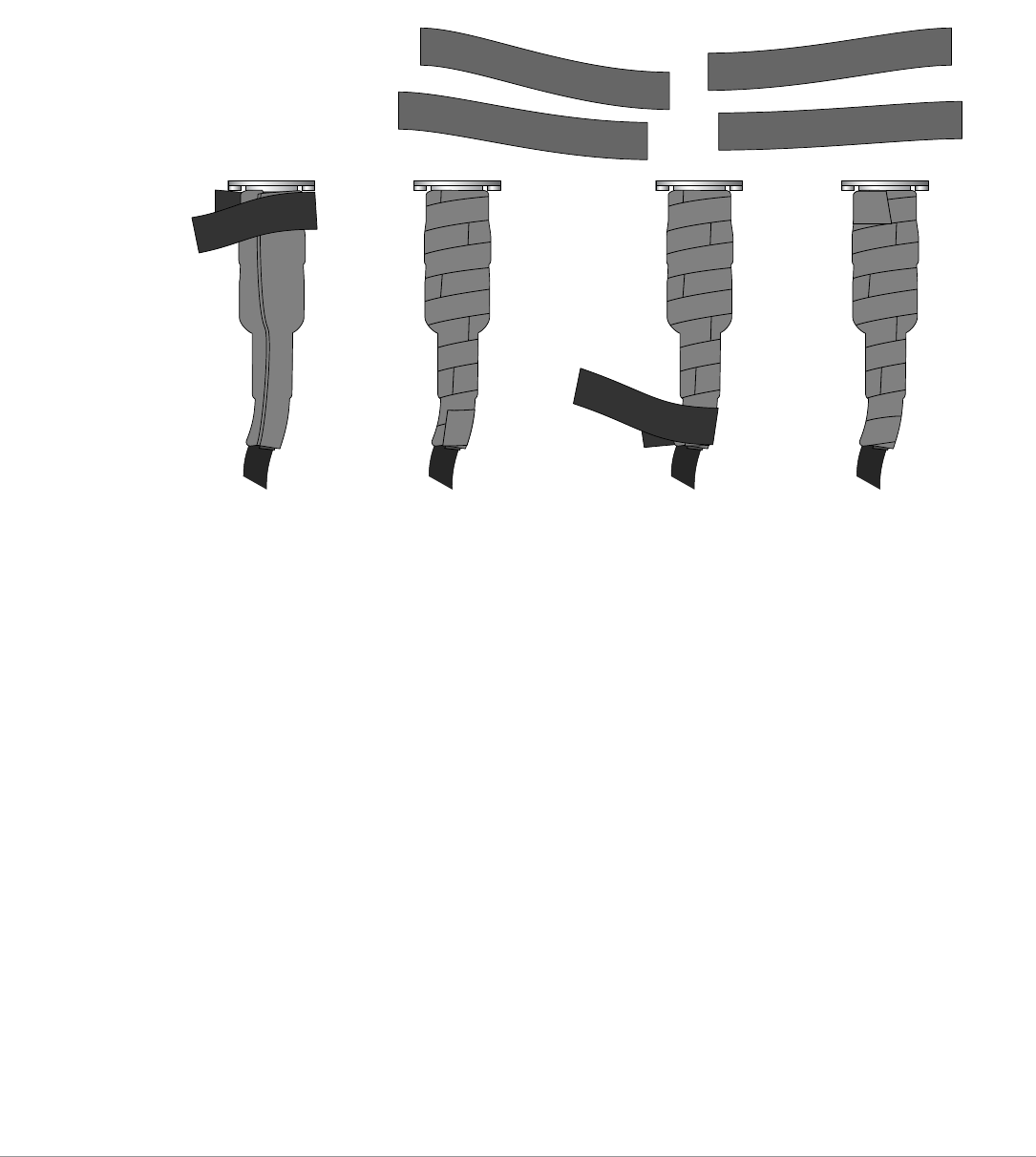
20 Aruba MSR4000 Wireless Mesh Router | Installation Guide
Second Wrapping of Tape
1. Cut a 4” (100 mm) strip of electrical tape from the roll.
2. Using 3/4” (19mm) electrical tape, begin wrapping at the connector and create four layers.
3. After completing the fourth layer of tape, check your work to ensure there are no places where water
can collect. If there are, you must smooth out those areas with additional layers of tape or remove the
weatherproofing and begin again.
Figure 17 Completed Wrapping
4. Repeat this process for all connectors.
Installing the MSR4000
The MSR4000 can be installed on a wall or attached to a pole. Pole diameter must be 40 to 60 mm at the
position where the MSR4000 will be mounted. The following section describes how to attach the necessary
hardware to the router and how to mount the router in the selected location.
Mounting Assembly
The mounting assembly for installing MSR4000 includes the following as shown in Figure 18 and Figure 19
Solar Shield
Mounting bracket
Pole anchors x 2
Bolts
First and third layers wrap
top to bottom
AP175_20
Pieces of tape as needed
Rubber will be wrapped
with 4 layers of tape
Second and final layers wrap
bottom to top
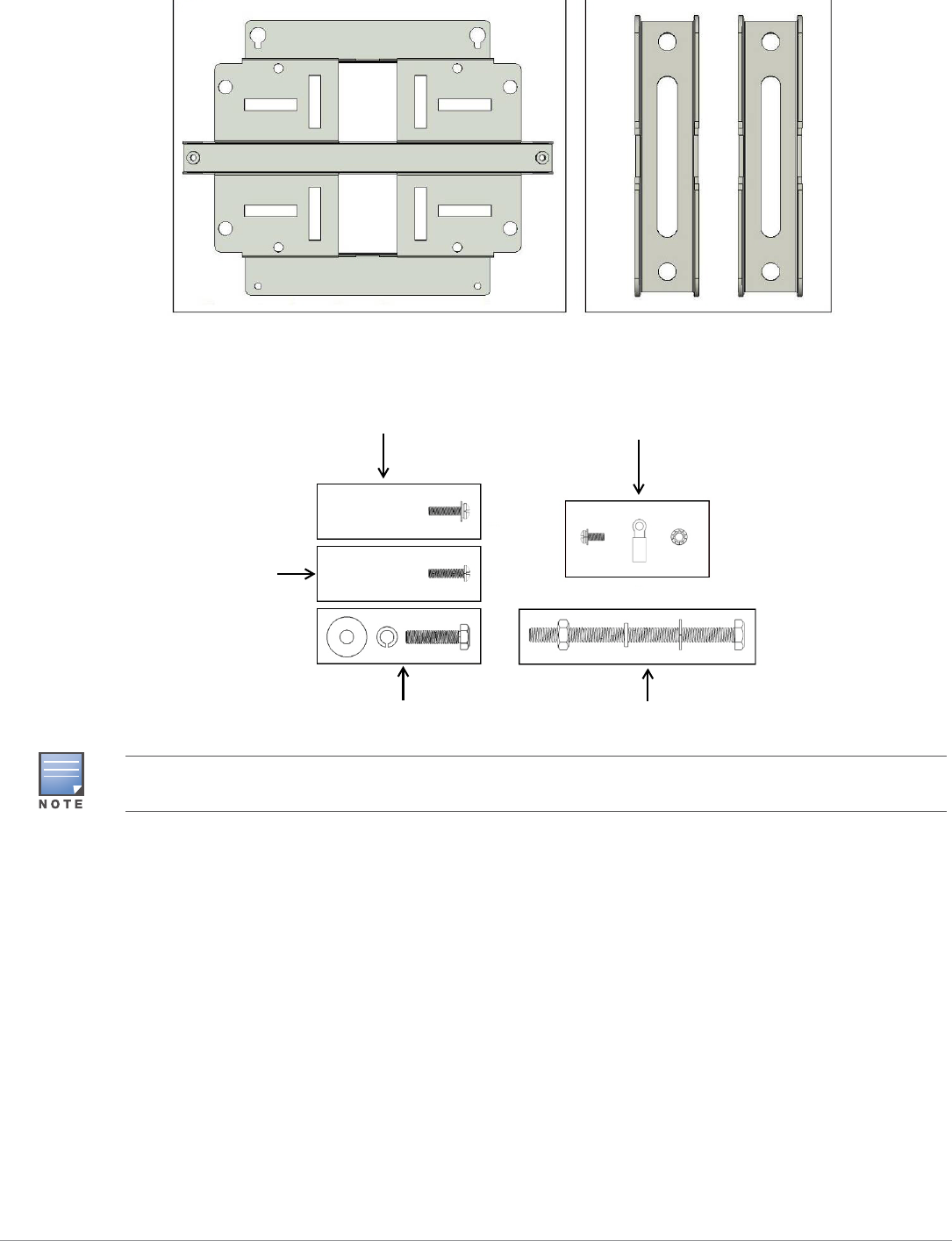
Aruba MSR4000 Wireless Mesh Router | Installation Guide 21
Figure 18 The Mounting Bracket and Pole Anchors
Figure 19 Bolts
Installing the MSR4000 on a Pole
1. Attach the solar shield on MSR4000 using the four M4 x16 bolts (with flat and spring washers) on the
four screw holes of the MSR4000.
Pole Anchors
Mounting Bracket
{M4 x16 bolt, flat washer, spring washer}x4 {M4 x12 bolt, external-tooth washer, OT copper lug}x1
{M4 x16 bolt}x2
{M6 x30 bolt, flat washer, spring washer}x2 {M8 x110 bolt, flat washer, spring washer}x4
You can mount the MSR4000 on a pole with 96mm diameter using M8 x150 long bolts (not provided in the box
shipped with MSR4000).
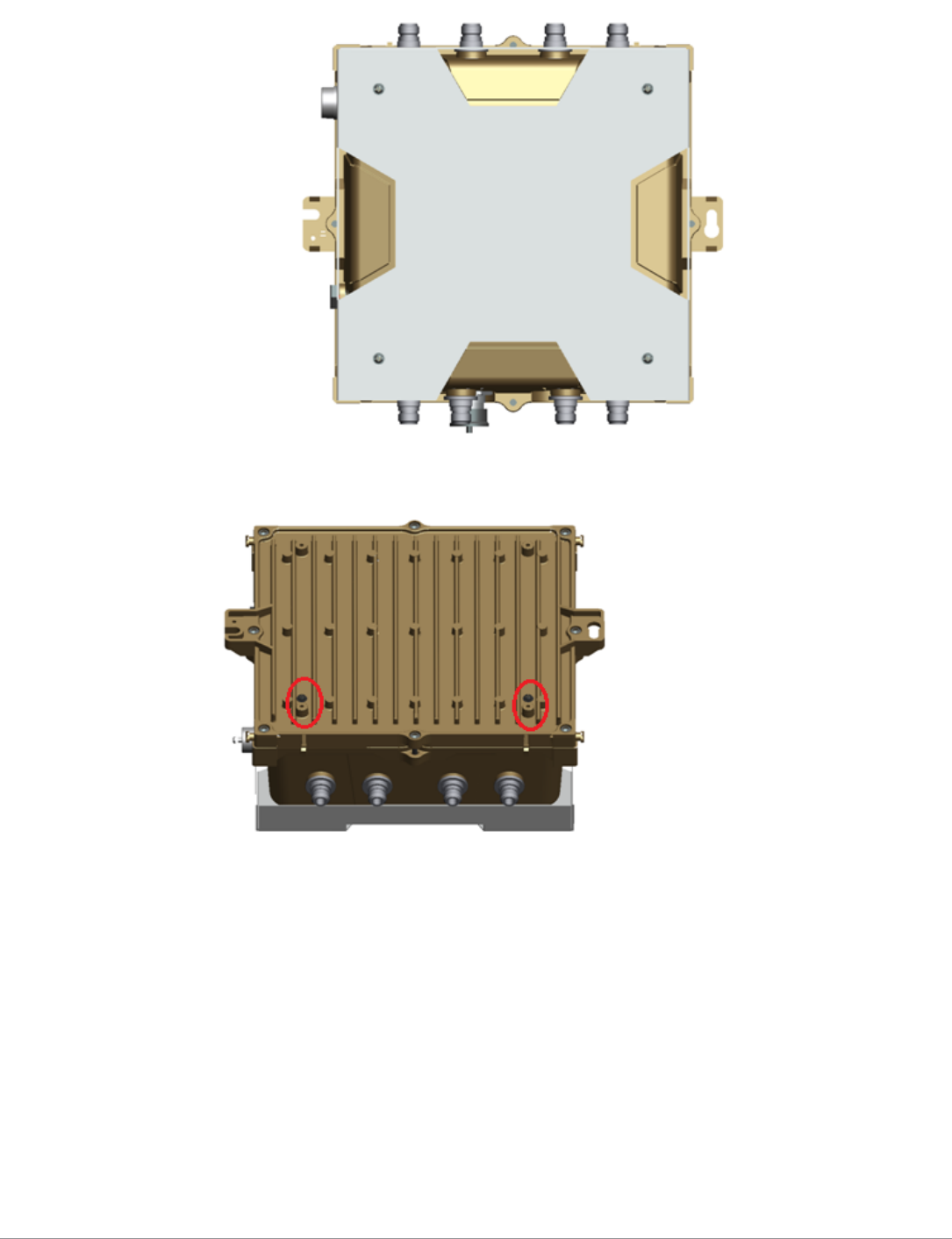
22 Aruba MSR4000 Wireless Mesh Router | Installation Guide
Figure 20 Attaching the Solar Shield to the MSR4000
2. Screw the two M4 x16 bolts into the holes on the back of the MSR4000.
Figure 21 Positions of Screw Holes on the Back of the MSR4000
3. Attach the mounting bracket and the pair of pole anchors on the pole using four M8 x110 bolts (with flat
washers, spring washers and nuts).
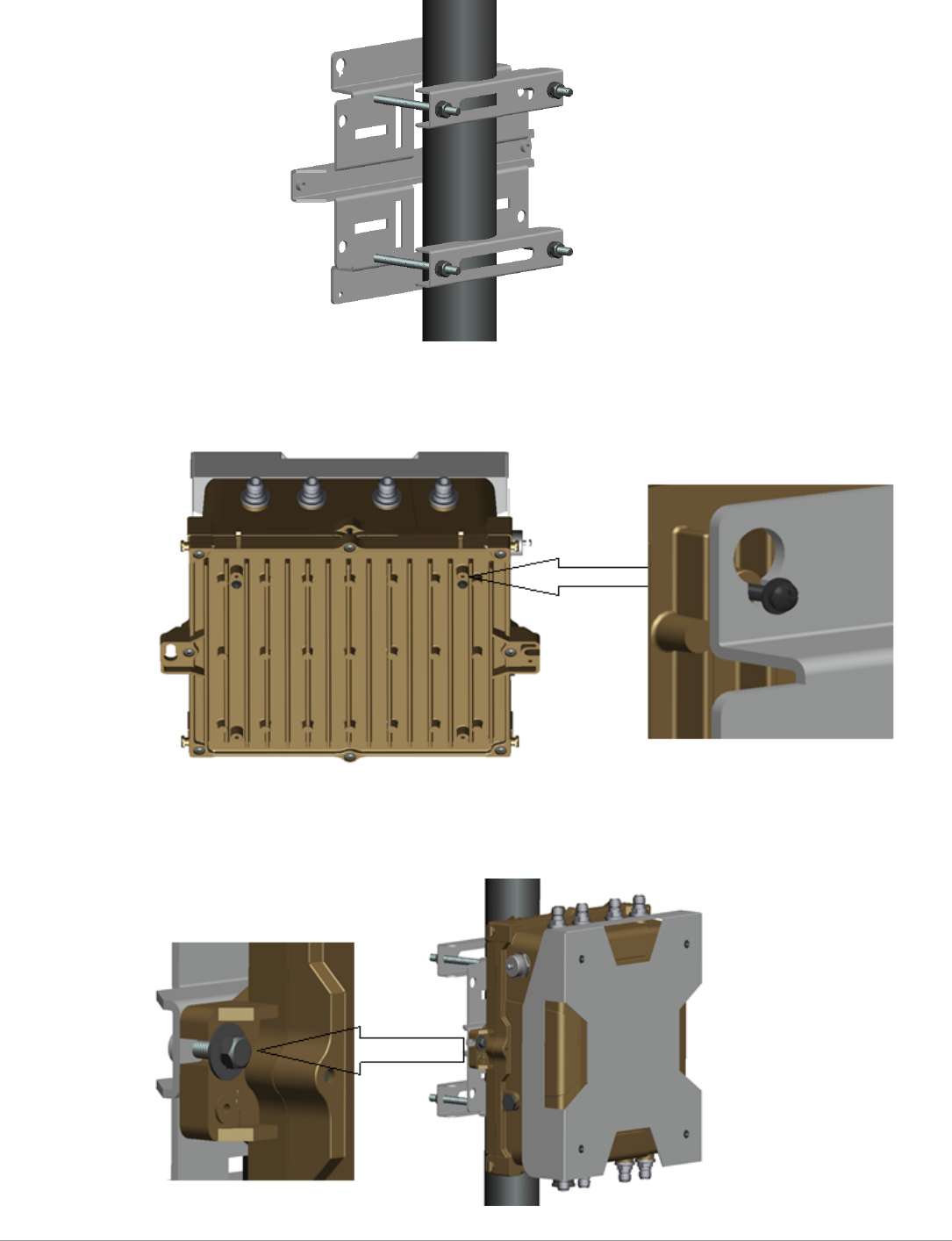
Aruba MSR4000 Wireless Mesh Router | Installation Guide 23
Figure 22 Attaching the Mounting Bracket and the Pole Anchors to the Pole
4. Align the two M4 x16 bolts installed on the back of MSR4000 with the holes on the mounting bracket and
hang the MSR4000 on the bracket.
Figure 23 Hanging the MSR4000 on the Mounting Bracket
5. Align the two installation holes on the two sides of the MSR4000 with the corresponding holes on the
mounting bracket and then use the two M6 x30 bolts (with flat and spring washers) to fix them. There is
screw thread in the screw hole of the solar shield.
Figure 24 Fixing the MSR4000 to the Mounting Bracket
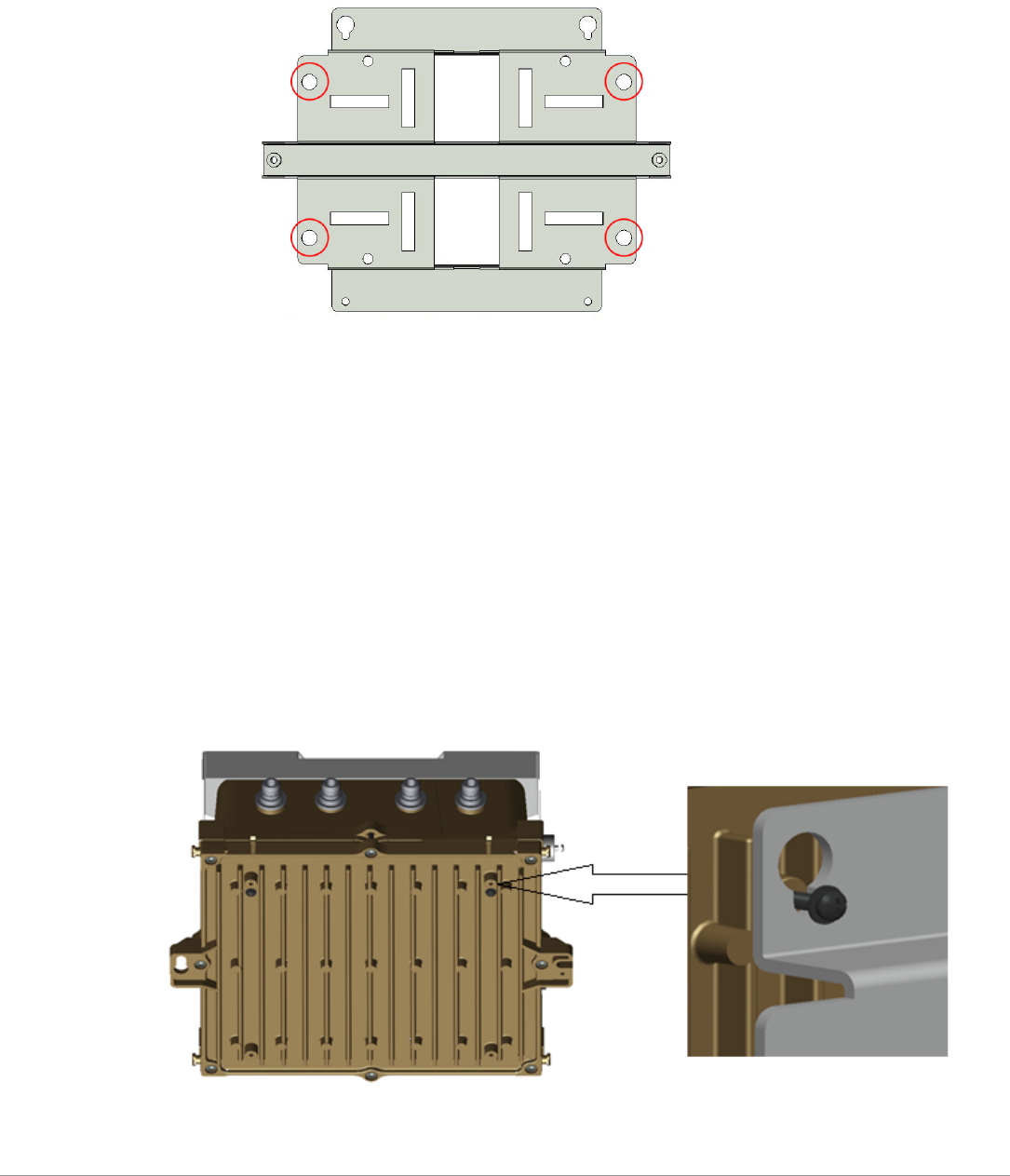
24 Aruba MSR4000 Wireless Mesh Router | Installation Guide
Installing the MSR4000 on a Wall
1. Begin by marking the screw points on the wall in the location you have selected.
a. Put the mounting bracket on the installation position against the wall.
b. Mark four expansion screw holes on the wall.
Figure 25 Position of the Screw Holes on the Mounting Bracket
2. Use a drill to create four holes on the four markings you created in the previous step.
3. Install wall (masonry) anchors.
a. Insert a masonry anchor into each drilled hole.
b. Tap the flat end of the anchor with a rubber hammer until the anchor is flush with the wall surface.
4. Attach the mounting bracket to the wall.
a. Align the four holes in the mounting bracket with the anchors and insert four expansion screws
through the installation holes into the anchors.
b. Adjust the position of the mounting bracket and tighten the expansion screws.
5. Hang the MSR4000 on the bracket.
a. Screw the two M4 x16 bolts into the holes on the back of the MSR4000.
b. Align the two M4 x16 bolts on the back of MSR4000 with the holes on the mounting bracket and hang
the MSR4000 on the mounting bracket.
Figure 26 Hanging the MSR4000 on the Mounting Bracket
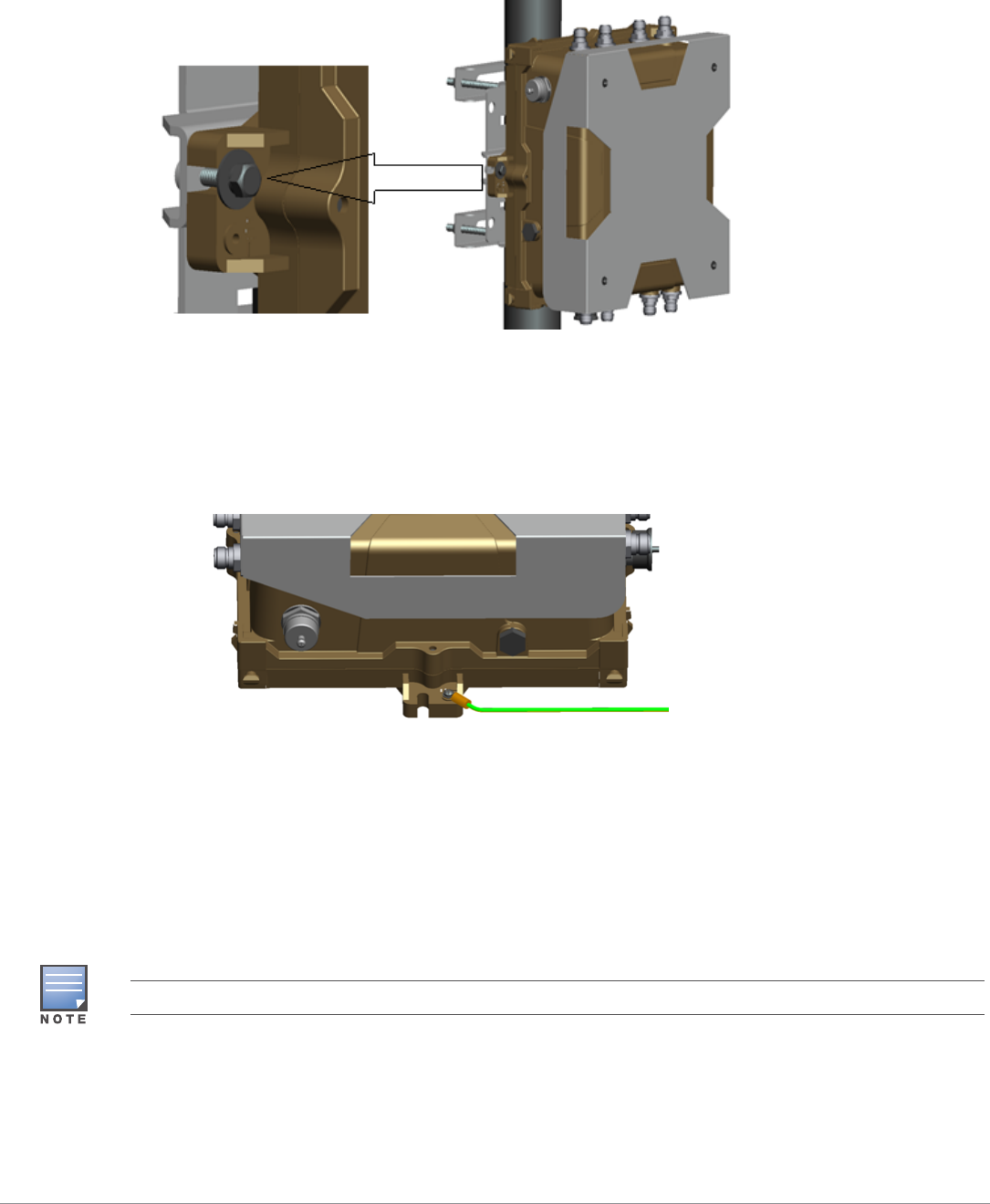
Aruba MSR4000 Wireless Mesh Router | Installation Guide 25
6. Align the two installation holes on the two sides of the MSR4000 with the corresponding holes on the
mounting bracket and then use the two M6 x30 bolts (with flat and spring washers) to fix them. There is
screw thread in the screw hole of the solar shield.
Figure 27 Fixing the MSR4000 to the Mounting Bracket
Grounding the MSR4000
The grounding must be completed before powering up the MSR4000. The resistance of grounding wire
should be less than 5 ohm and the grounding cable’s cross-section area should be no less than 6 square
mm.The grounding hole is at the left side of the MSR4000.
Figure 28 Grounding the MSR4000
1. Peel the cover of one end of the grounding cable (green or yellow and green grounding cable with 6 mm
cross-section area) and place the bare grounding cable into the copper lug, and press firmly with the
crimping pliers.
2. Fasten the copper lug to the grounding hole on the MSR4000 with the M4 x12 bolt and external-tooth
washer.
Connecting the RF Cable
The RF cable is used to connect the antenna and the MSR4000.
You must install the lightning arrester between the antenna and the MSR4000
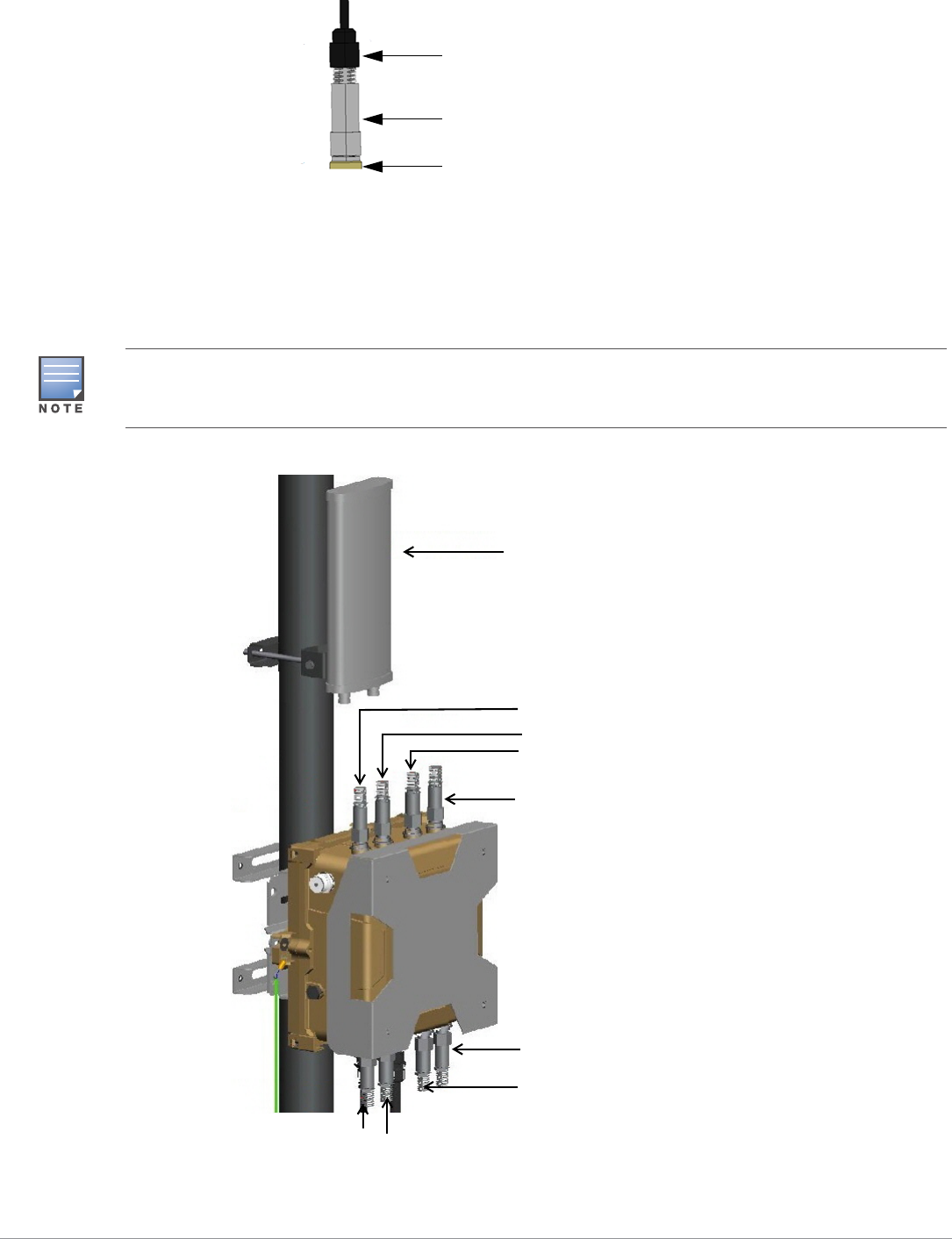
26 Aruba MSR4000 Wireless Mesh Router | Installation Guide
Figure 29 Connecting the RF Cable
1. Screw one end of the lightning arrester onto the antenna interface.
2. Connect the RF cable to the other end of the lightning arrester.
3. Waterproof the antenna connection with PVC insulation tape, adhesive insulation tape, and strap.
4. Place the included metal weatherproof caps over any unused antenna interfaces by turning them
clockwise until hand tight.
Figure 30 Antenna Interfaces on the MSR4000
RF Cable with N Type Connector
Lightning Arrester
Antenna Interface on MSR4000
One directional dual-polarization antenna needs two RF cables to connect to the two corresponding antenna
interfaces on MSR4000. For example, if the antenna needs to connect to Radio 1 on MSR4000, the RF cables from
antenna need to connect to the two antenna interfaces (Radio1) as shown in Figure 30
Directional Antenna
Antenna1 (Radio 3)
Antenna1 (Radio 1)
Antenna1 (Radio 0)
Antenna1 (Radio 2)
Antenna2 (Radio 2)
Antenna2 (Radio 1)
Antenna2 (Radio 3)
Antenna2 (Radio 0)
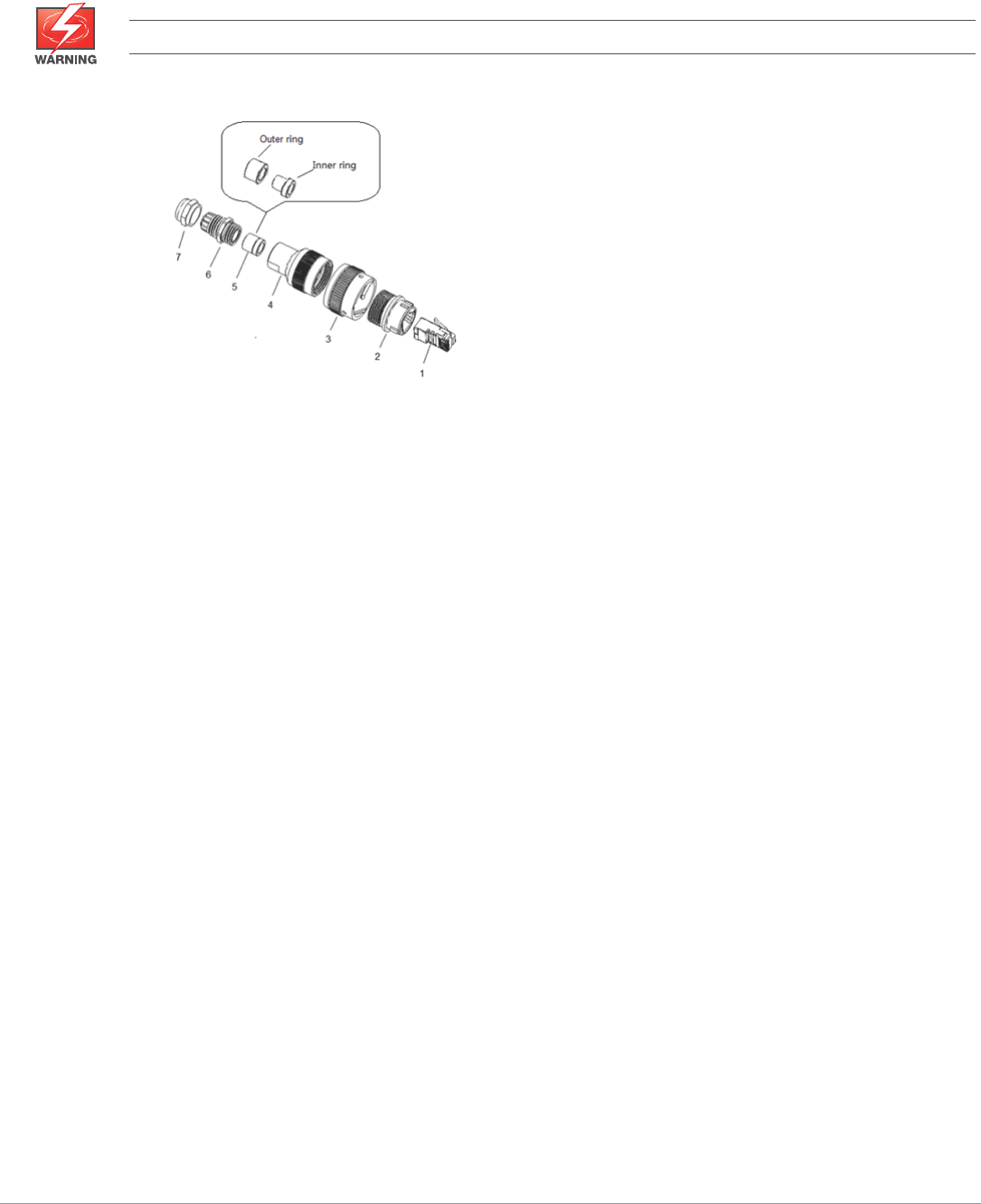
Aruba MSR4000 Wireless Mesh Router | Installation Guide 27
Connecting the Ethernet Cable
To ensure that MSR4000 maintains Ethernet connectivity and Power over Ethernet (PoE), you must use the
included weatherproof connector kit and install it using the steps below.
Figure 31 Weatherproof Ethernet Connector Kit
1. Hold the clamp ring (4) vertically, with the wide end facing up, and place the locknut (3) over it.
2. Drop the weatherproof connector socket (2) into the locknut/clamp ring items (3,4), with the RJ45
connector opening facing up, and screw the socket into the threads on the clamp ring.
3. Place the sealing nut (7) over an Ethernet cable (without a connector attached to the end).
4. Place the seal bolt (6) over the Ethernet cable.
5. Strip off about 55mm (2 inches) of the outer Ethernet cable sheath to expose the ground wire and other
pair wires.
6. Insert all pair wires into the two shield rings (5).
7. Make the ground wire attach to the narrow end of the inner ring and place the outer ring over the narrow
end of the inner ring.
8. Insert the Ethernet cable into the narrow end of the clamp ring and pass it through the opening end of
weatherproof connector socket.
9. Using a crimping tool, attach the included shielded RJ45 connector.
10. Slide the shield rings up the Ethernet cable and insert it into the narrow end of the clamp ring.
11. Pull the Ethernet cable so the shielded RJ45 connector fits into the RJ45 shaped opening in the wide end
of the weatherproof connector socket.
12. Slide the sealing bolt over the narrow end of the clamp ring and hand tighten it.
13. Thread the sealing nut onto the sealing bolt.
14. Insert the Ethernet cable connector into the Ethernet interface and hand-tighten the locknut.
15. Water-proof the Ethernet cable connection with electrical tape and butyl rubber.
Failure to use the included weatherproof connector kit can lead to connectivity and PoE issues.
1 Shielded RJ45 connector 5 Shield rings
2 Weatherproof Connector Socket 6 Sealing Bolt
3 Locknut 7 Sealing Nut
4 Clamp ring
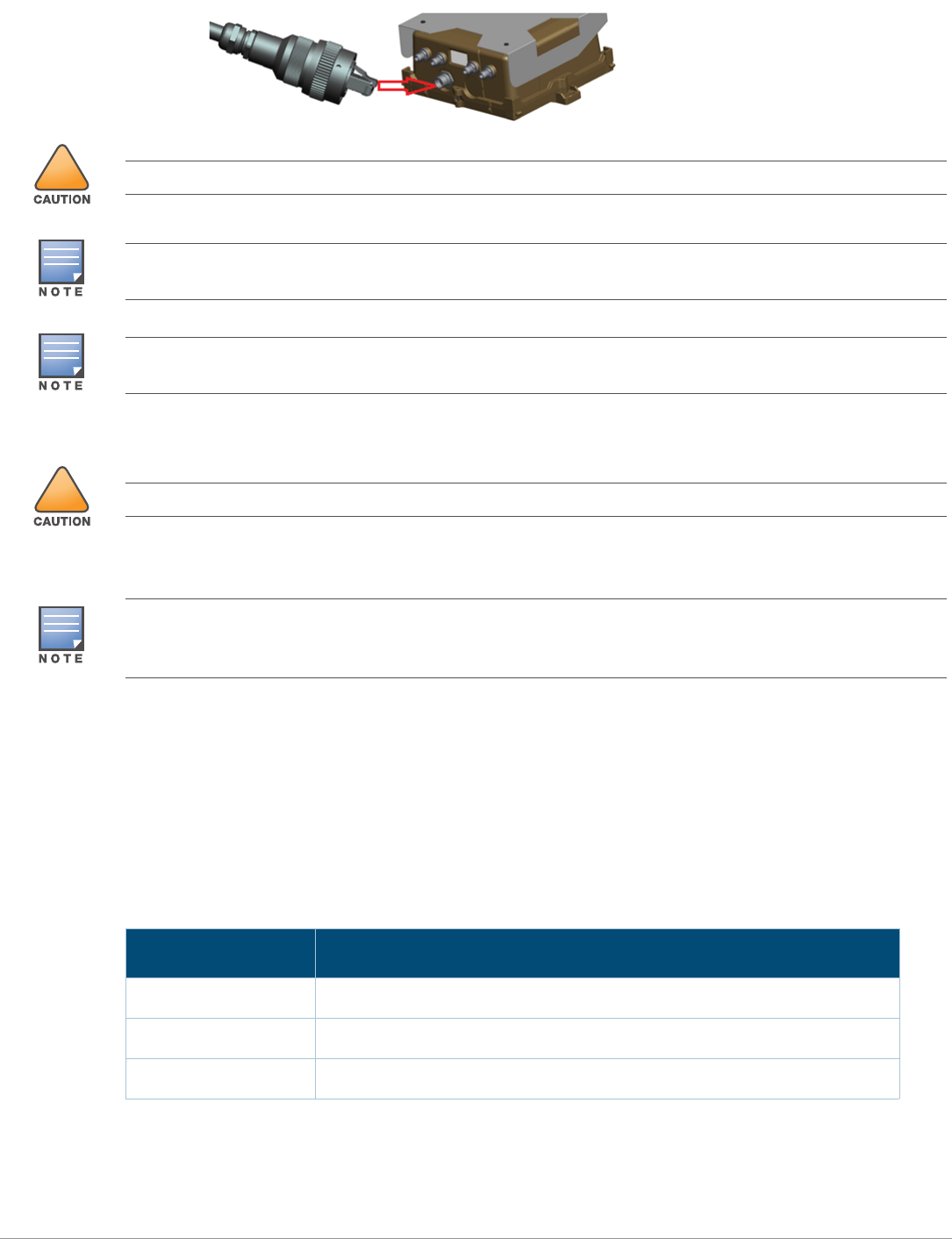
28 Aruba MSR4000 Wireless Mesh Router | Installation Guide
Figure 32 Connecting the Ethernet Cable
Connecting the Power Cable (MSR4KAC)
The MSR4KAC versions need an outdoor rated power cable to connect to a compatible AC power source.
AC power source specifications (at MSR4000 interface): 100-240Vac, 100W
Powering the MSR2KAC
The MSR4KAC has two power cord variants and a kit is also offered to allow customers to assemble their
own cable if the standard offerings do not meet deployment needs.
The following table summarizes the powering accessories available for the applicable SKUs for the
MSR4KAC units:
The difference between the NA and INTL AC cable part is the color coding of the conductors.
The North American cable uses Black (Hot), White (Neutral), and Green (Ground).
!
For outdoor use, the RJ45 must be installed with a waterproofing gasket.
The Ethernet cable and power cable need proper drip loops. Drip loops prevent water from entering the router
through the connectors.
It is recommended to fix the Ethernet cable near the MSR4000 side to the wall or the pole. This is to ensure that the
weight of the cable does not affect the RJ45 connector.
!
Installation and service of Aruba Networks products should be performed by Professional Installers.
The MSR4000 does not ship with any power cables; these are available as accessories and should be ordered
separately. In addition to completed power cables, Aruba also offers an outdoor rated AC connector kit that can be
used to connect a compatible power cable to the MSR4000.
Table 5 SKUs for Powering Options
Part Number Description
CBL-AC-NA Weatherproof AC power cable (5m), North America version
CBL-AC-INTL Weatherproof AC power cable (5m), International (EU) version
CKIT-AC-M Weatherproof connector kit for AC power interface
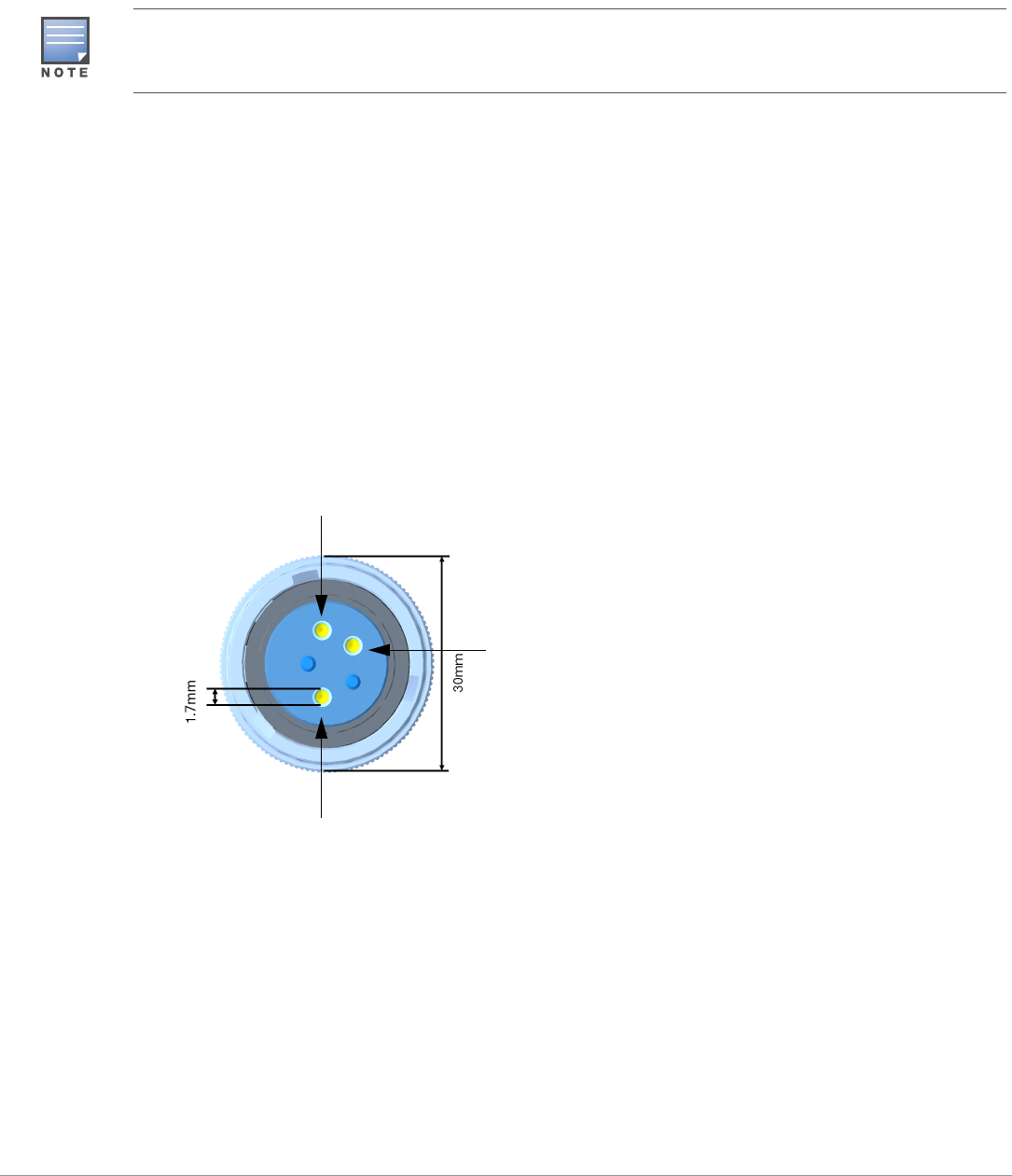
Aruba MSR4000 Wireless Mesh Router | Installation Guide 29
The INTL part follows the international schema of Brown (Hot), Blue (Neutral) and Yellow/Green
(Ground).
Best Practices for Outdoor Connection to AC Mains
With virtually all infrastructure equipment that is installed outdoors connection to AC mains should be
accomplished with an outdoor rated junction box.
In the event that a plug is wired onto the cable assembly, the electrician must follow all instructions
provided while attaching a plug to the cable assemblies. The connections must be consistent with the
local electrical code. The use of plugs with infrastructure equipment is suitable only for temporary
installations where the nuisance tripping of the GFI plugs is considered tolerable.
Using the CKIT-AC-M
The assembly instructions for the CKIT-AC-M is shipped along with the parts. All instructions must be
followed to ensure proper assembly of the connector onto the cable.
The specifications for third-party cables used with the CKIT solution are as follows:
AC power cable specifications (when using AC connector kit and custom cable): minimum voltage/
current rating 250V/1A, diameter 6-12mm, rated for outdoor use
AC Power Cable Connector PIN OUT
Figure 33 AC Power Cable Connector
Connecting the Power Cable to the MSR4KAC
1. Remove the protective cap on the power interface.
2. Insert the power cable connector into the power interface and hand-fasten the locknut.
3. Water-proof the power cable connection with PVC insulation tape, adhesive insulation tape and strap.
The connection to the AC mains must be implemented by a qualified resource in a manner that is consistent with
the electrical code in force in the jurisdiction of deployment. In many countries a licensed electrician must perform
this operation. In Japan, this would require an electrician certified by the Ministry of Economy, Trade, and Industry.
AC Power Cable Connector
Hot
Ground
Neutral
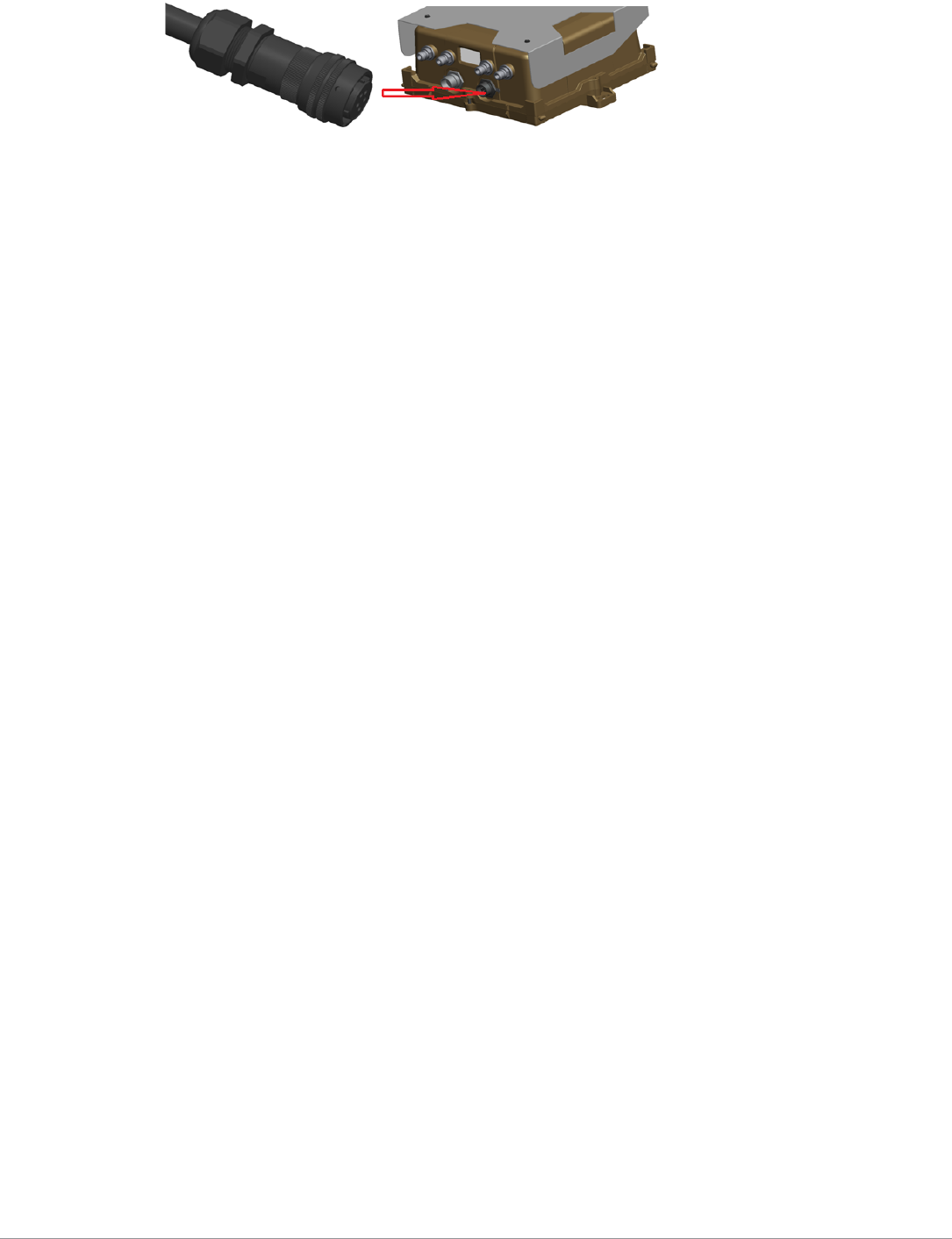
30 Aruba MSR4000 Wireless Mesh Router | Installation Guide
Figure 34 Connecting the Power Cable

Aruba MSR4000 Wireless Mesh Router | Installation Guide 31
Product Specifications
Mechanical
Dimensions (H x W x D)
13 inches x 11.5 inches x 5.0 inches
325mm x 290 mm x 135 mm
Weight:
MSR4KP: 12.0 lbs/5.5 kg
MSR4KAC: 14.3 lbs/6.5 kg
Shipping Dimensions (H x W x D)
16.3 inches x 13.9 inches x 16.9 inches
415 mm x 352 mm x 428 mm
Shipping Weight:
MSR4KP: 25.9lbs/11.75 kg
MSR4KAC: 28.1 lbs/12.75 kg
Temperature
Operating (MSR2KP): -30ºC to 60ºC (-22ºF to 140ºF)
Operating (MSR2KAC): -40ºC to 55ºC (-40ºF to 131ºF)
Storage: –30ºC to 70ºC (-22ºF to 158ºF)
Mounting: wall or pole mountable
Antennas:
Eight, N-type interfaces for external antenna support
Feeder cable may be used for external antenna deployments
Visual Status Indicators (LEDs): See Table 2 and Table 3
Electrical
Power
MSR4KP: High power PoE (60 watts) input required
MSR4KAC: 100-240 volt AC 50/60 Hz
Maximum power consumption: 36 watts (excludes power consumed by any POE device connected to
and powered by the MSR4KAC)
Interfaces
Network:
1 x 10/100/1000BASE-T Ethernet (RJ-45), auto-sensing link speed and MDI/MDX
Power:
1 x AC power connector (in MSR2KAC model only)
Antenna:
8 x N-Type antenna interfaces
Other:
1 x USB console interface

32 Aruba MSR4000 Wireless Mesh Router | Installation Guide
Wireless LAN
Router type: Outdoor, dual-radio, dual-band plus 4.9GHz public safety band
Supported frequency bands (country-specific restrictions apply):
2.400 to 2.483 GHz
4.900 to 5.100 GHz
5.150 to 5.250 GHz
5.250 to 5.350 GHz
5.470 to 5.725 GHz
5.725 to 5.850 GHz
Available channels: Dependent upon configured regulatory domain
Supported radio technologies:
802.11b: Direct-sequence spread-spectrum (DSSS)
802.11a/g/n: Orthogonal frequency division multiplexing (OFDM)
802.11n: 2x2 MIMO with two spatial streams
Supported modulation types:
802.11b: BPSK, QPSK, CCK
802.11a/g/n: BPSK, QPSK, 16-QAM, 64-QAM
Maximum transmit power: 25 dBm (325 mW) (limited by local regulatory requirements)
Association rates (Mbps):
802.11b: 1, 2, 5.5, 11
802.11a/g: 6, 9, 12, 18, 24, 36, 48, 54
802.11n: MCS0 - MCS15 (6.5 Mbps to 300 Mbps)
802.11n high-throughput (HT) support: HT 20/40
802.11n packet aggregation: A-MPDU, A-MSDU
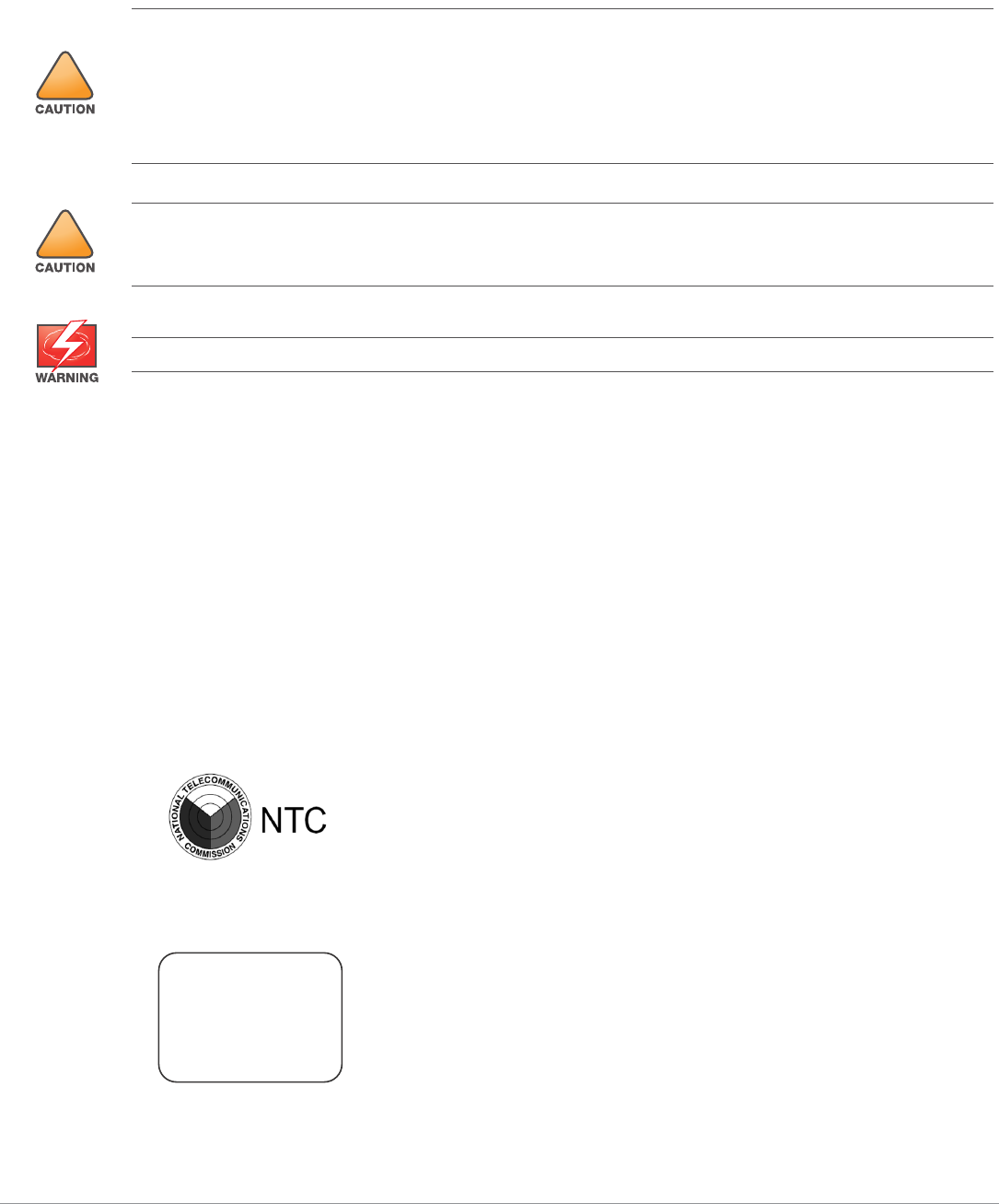
Aruba MSR4000 Wireless Mesh Router | Installation Guide 33
Safety and Regulatory Compliance
Aruba Networks provides a multi-language document that contains country-specific restrictions and
additional safety and regulatory information for all Aruba access points. This document can be viewed or
downloaded from the following location: www.arubanetworks.com/safety_addendum
FCC Class B Device
This equipment has been tested and found to comply with the limits for a Class B digital device, pursuant to part 15 of
the FCC Rules. These limits are designed to provide reasonable protection against harmful interference in a residential
installation. This equipment generates, uses and can radiate radio frequency energy and, if not installed and used in
accordance with the instructions, may cause harmful interference to radio communications. However, there is no
guarantee that interference will not occur in a particular installation. If this equipment does cause harmful interference
to radio or television reception, which can be determined by turning the equipment off and on, the user is encouraged to
try to correct the interference by one or more of the following measures:
Reorient or relocate the receiving antenna.
Increase the separation between the equipment and receiver.
Connect the equipment into an outlet on a circuit different from that to which the receiver is connected.
Consult the dealer or an experienced radio/ TV technician for help.
For a complete list of Country Specific Regulations please speak with your Aruba Representative.
Philippines NTC (MSR4KP)
UAE (MSR4KP)
!
RF Radiation Exposure Statement: This equipment complies with FCC RF radiation exposure limits. This
equipment should be installed and operated with a minimum distance of 13.78 inches (35 cm) between the radiator
and your body for 2.4 GHz and 5 GHz operations. This transmitter must not be co-located or operating in
conjunction with any other antenna or transmitter. When operated in the 5.15 to 5.25 GHz frequency range, this
device is restricted to indoor use to reduce the potential for harmful interference with co-channel Mobile Satellite
Systems.
!
Aruba Access Points and the AP-LAR-1 lightning arrestor are required to be installed by a professional installer. The
professional installer is responsible for ensuring that grounding is available and it meets applicable local and
national electrical codes.
Do not work on a router and do not connect or disconnect cables during periods of lightning activity.
Type-Approval No.
ESD-CPE-1206004C
200202320G
TRA
REGISTERED No:
DEALER No:
DA0039425/10
ER0055300/11
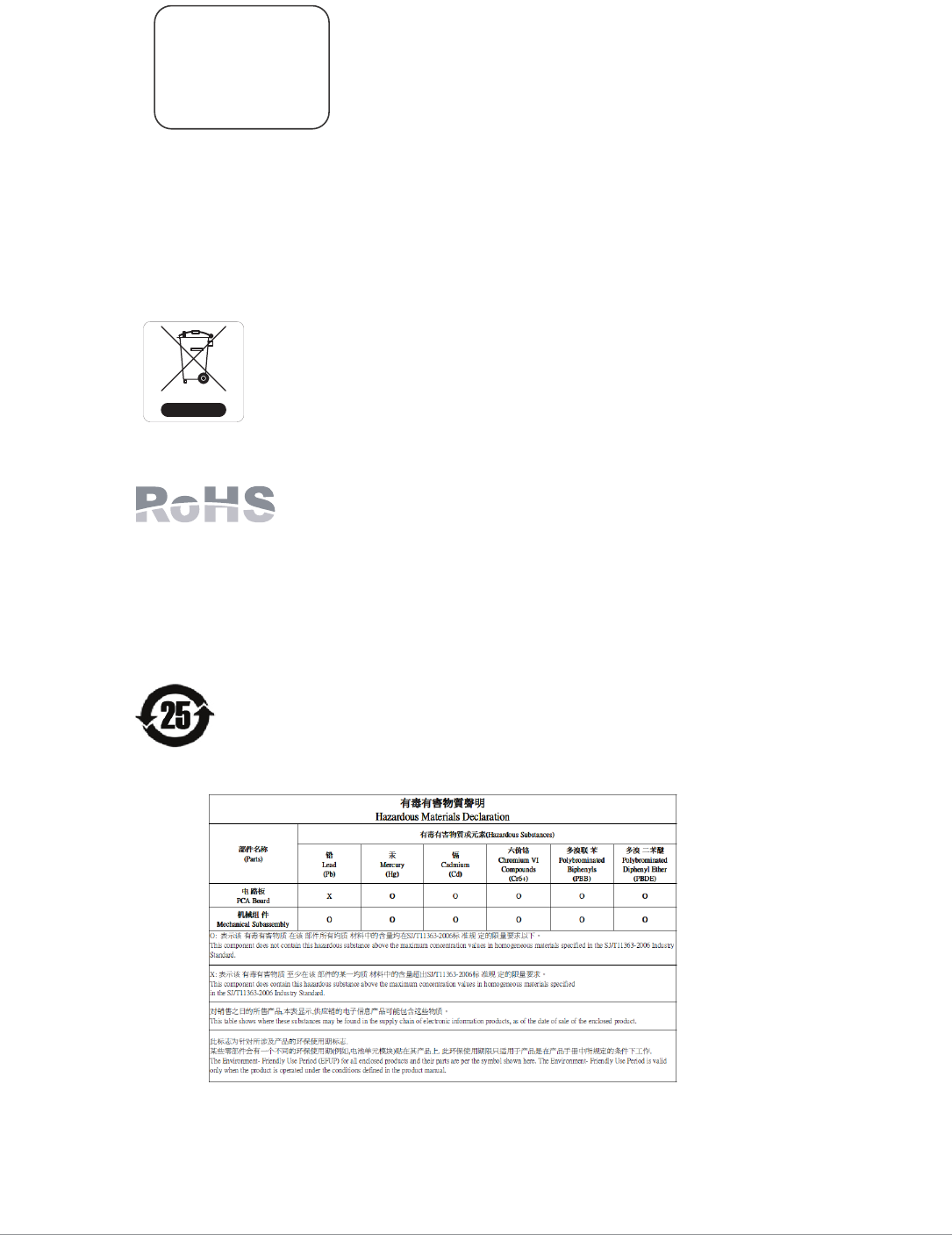
34 Aruba MSR4000 Wireless Mesh Router | Installation Guide
UAE (MSR4KAC)
Proper Disposal of Aruba Equipment
For the most current information about Global Environmental Compliance and Aruba products, see our website at
www.arubanetworks.com.
Waste of Electrical and Electronic Equipment
Aruba products at end of life are subject to separate collection and treatment in the EU Member
States, Norway, and Switzerland and therefore are marked with the symbol shown at the left
(crossed-out wheelie bin). The treatment applied at end of life of these products in these countries
shall comply with the applicable national laws of countries implementing Directive 2002/96EC on
Waste of Electrical and Electronic Equipment (WEEE).
European Union RoHS
Aruba products also comply with the EU Restriction of Hazardous Substances Directive 2002/
95/EC (RoHS). EU RoHS restricts the use of specific hazardous materials in the manufacture of
electrical and electronic equipment. Specifically, restricted materials under the RoHS Directive
are Lead (including Solder used in printed circuit assemblies), Cadmium, Mercury, Hexavalent
Chromium, and Bromine. Some Aruba products are subject to the exemptions listed in RoHS Directive Annex 7 (Lead in
solder used in printed circuit assemblies). Products and packaging will be marked with the “RoHS” label shown at the
left indicating conformance to this Directive.
China RoHS
Aruba products also comply with China environmental declaration requirements and are labeled with
the “EFUP 25” label shown at the left.
For MSR4KP:
200202320G
TRA
REGISTERED No:
DEALER No:
DA0039425/10
ER0082361/12
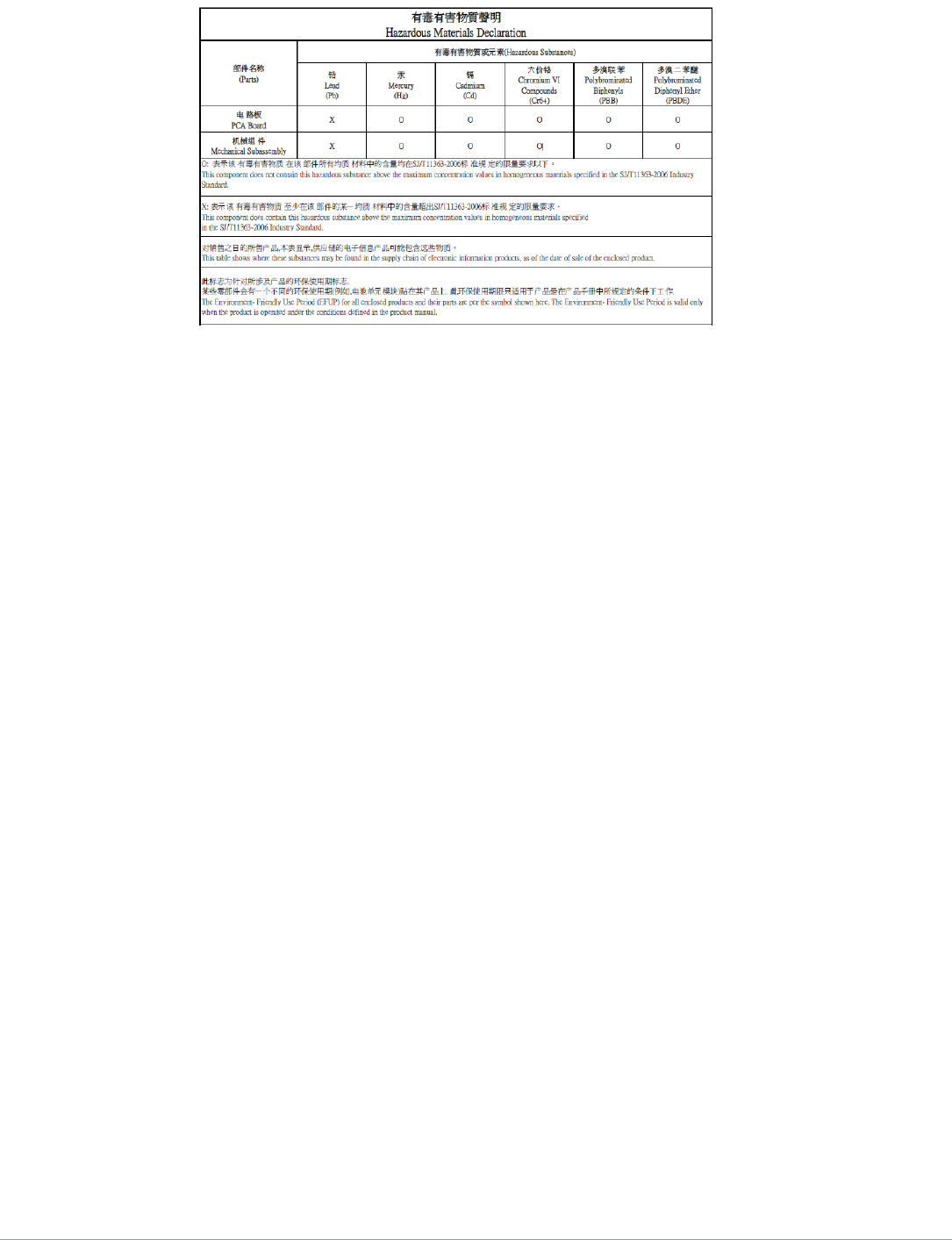
Aruba MSR4000 Wireless Mesh Router | Installation Guide 35
For MSR4KAC:
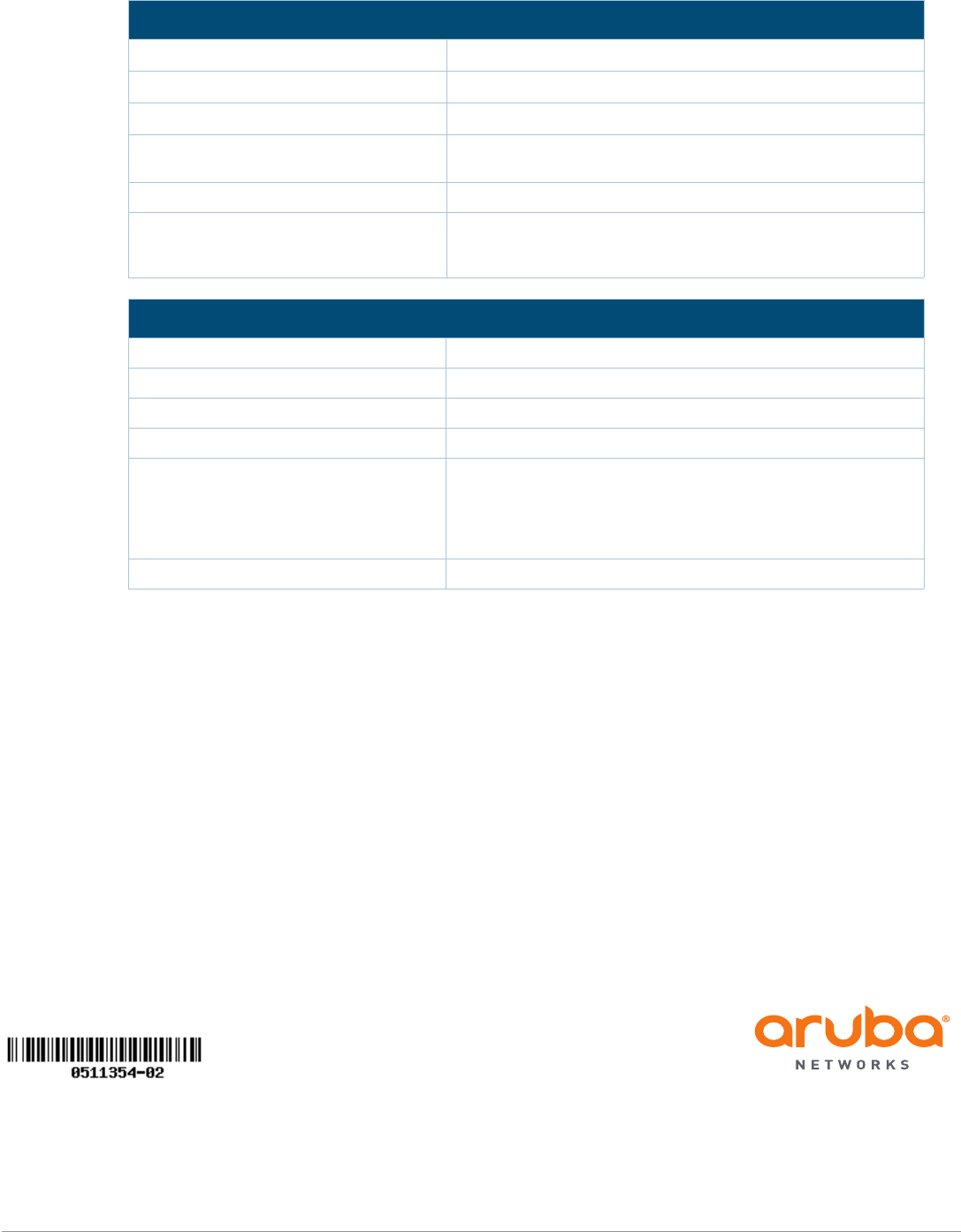
© 2014 Aruba Networks, Inc. All rights reserved.
www.arubanetworks.com
1344 Crossman Avenue
Sunnyvale, California 94089
Phone: 408.227.4500
Fax 408.227.4550
36 Aruba MSR4000 Wireless Mesh Router | Installation Guide
Contacting Aruba Networks
Web Site Support
Main Site http://www.arubanetworks.com
Support Site https://support.arubanetworks.com
Software Licensing Site https://licensing.arubanetworks.com/login.php
Wireless Security Incident
Response Team (WSIRT)
http://www.arubanetworks.com/support/wsirt.php
Support Emails support@arubanetworks.com
WSIRT Email
Please email details of any security
problem found in an Aruba product.
wsirt@arubanetworks.com
Telephone Support
Aruba Corporate +1 (408) 227-4500
FAX +1 (408) 227-4550
Support
United States 800-WI-FI-LAN (800-943-4526)
Universal Free Phone Service Number
(UIFN): Australia, Canada, China,
France, Germany, Hong Kong, Ireland,
Israel, Japan, Korea, Singapore, South
Africa, Taiwan, and the UK.
+800-4WIFI-LAN (+800-49434-526)
All Other Countries +1 (408) 754-1200